CMS men’s soccer season canceled due to ‘demeaning and potentially dangerous’ acts of hazing
ANSLEY WASHBURN
Due to a hazing incident that took place on Claremont McKen na College’s campus Oct. 1, Cla remont-Mudd-Scripps Athletics canceled the men’s soccer program for the remainder of the fall 2022 season, CMS Athletics announced Wednesday.
Word of hazing new team mem bers in the CMS men’s soccer team frst led to the cancellation of Sat urday’s rivalry game against Po mona-Pitzer (PP), then their entire athletic season four days later.
On Oct. 6, the CMS Athletics department, in partnership with the CMC and Harvey Mudd College Deans of Students Ofces, launched an investigation into the team’s po tential violations against the CMS Athletics Student Athlete Code of Conduct and Hazing Policy.
“The investigation found that nearly all members of the team, acting as a team, violated multiple conduct standards, including or ganizing and carrying out an event which subjected new team members to multiple acts of hazing,” the CMS release explained. “As a result, the remainder of the men’s fall soccer season is canceled, including any opportunities for SCIAC and NCAA tournament play.”
According to the statement, the members of the men’s soccer team cooperated fully with the incident review.
CMS men’s soccer players and coaches did not respond to TSL’s request for comment.
Following the announcement of the men’s soccer season shutdown, Dianna Graves, CMC’s associate vice president and dean of students, sent an email Thursday evening to the CMC student body describing the
initial incident as “an event which subjected new team members to acts of hazing that were demeaning and potentially dangerous.”
The email exhorted all students to reconsider actions that take place during organized community events, providing a list of questions for students to ask themselves.
“I want to remind all of our stu dents — whether on teams, clubs, research groups or other kinds of organizations — that we each have a duty to ensure that events and gatherings support the goals of the program and are conducted in a safe, responsible, inclusive manner,” Graves said in the email.
Additionally, in an email leaked to TSL, CMC Ofce of Admissions gave tour guides instructions for how to respond to questions con cerning the hazing incident and asked students to review “talking points” prepared by the college and Associate Vice President for Admission and Financial Aid Jenn Sandoval-Dancs.
“CMS has put out a public statement and the TSL will be covering the story,” the email sent by Rachelle Ehrman, CMC senior assistant dean of admission, said.
“As a result, you may get asked about [the hazing incident] on tours over the next several weeks.”
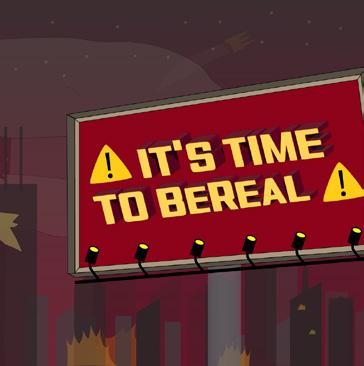
Ehrman told student tour guides “you should not bring [the hazing incident] up, [the talking points are] only if you get direct questions.”
CMC’s communications repre sentative Gilien Silsby declined to comment on the nature of the haz ing. Meanwhile, Judy Augsburger, HMC’s director of public relations, told TSL that the college does not have anything to add to the CMS statement that was released Wednesday.
CMS Athletics and the college
CMC trustees sends race GE proposal back to faculty
SAJAH ALI & MAXINE DAVEY
On Sept. 30, Claremont McKenna College’s Board of Trustees (BOT) unanimously remanded a facultyapproved proposal for a general education requirement that would focus on racial-ethnic cultural understanding, saying it “is not sufciently strong or well-tailored to fulfll our mission,” according to an Oct. 7 email to CMC students.

In the statement, the BOT added that the proposal needs to be “strengthened in several key respects to develop a broad and compelling curriculum” to remain in “strong alignment” with the college’s mission.
As such, the BOT handed the GE back to faculty, recommending that it be expanded beyond topics of race to include all “sources of division,” which range from sexual orientation to national origin, religion and disability.
The recommendations also include a call to expand the overlay course requirement beyond fve weeks to “become more pervasive, comprehensive and well-tailored” to meet curricula objectives.
While college bylaws only require faculty approval for curriculum additions, along with support from the BOT, the statement said the development of the curriculum “should come from a close, rigorous collaboration” between faculty, deans, students and President Hiram Chodosh.
The faculty-led proposal initially grew out of a response to the college’s initiative to address racism in 2020. However, a faculty-approved version of the proposal from April was handed back to professors last month, with Chodosh recommending
look to move past the incident for all parties involved, Graves said in the Thursday email to CMC students.
“The team is grappling with that loss, has taken accountability and will be working with CMS Athletics to restore and amplify the values of the program,” Graves said.
The Dean of Students Ofce and CMS Athletics have provided men tal health resources for the team members to help them cope with the repercussions of the Oct.1 haz ing incident, according to Graves.
“As is ofen the case in difcult times, the opportunities for growth and character building are signif icant, and we believe these stu
dent-athletes will be beter versions of themselves as they emerge from this difcult moment,” Graves said.
This is not the frst time CMS Athletics has dealt with hazing in cidents in recent years. In Feb. 2018, both the men’s and women’s track and feld teams were suspended during a potential conduct viola tion investigation, with the men’s team eventually barred from three meets and some members of the women’s team barred from one. In April 2019, the CMS baseball team landed a one-week suspension and played the rest of the season on pro bation, afer an investigation found they had violated the CMS hazing
Iranian students make their voices heard at Stand with Iran event
Prior to CMS’s decision to cancel the remainder of the season, the Stags sat at third in the SCIAC, with a conference record of 4-1-2 and an overall record of 4-3-5. The team was crowned SCIAC champions in 2021 and will now fnish this season out of contention altogether.
With all activities off the table for the rest of the season, the team will also not compete in the 1946 Challenge, CMS’s annual athletics fundraising program.
Pomona dining hall workers to hold strike vote
Oct. 20
MARIANA DURAN
With no contractual agreement in sight, Pomona College dining hall workers set a vote for Oct. 20, which, if passed, will allow union organizers to call in a strike to protest for higher wages in their new contract.
CW: Violence
After the death of Zhina Amini and the resulting mass protests in Iran, Southwest Asian and North African (SWANA) group leaders Sahar Dabirian PZ ’24, Tania Azhang PZ ’25 and Noura Tagdiri PZ ’24 decided to organize an event where Ira nians could share their stories and bring understanding to non-Iranians.
Stand with Iran, an event open to students throughout the Claremont Colleges, took place on Sunday at 3 p.m. at Pitzer’s Grove House. At the event, fve speakers — the event leaders and two guest speakers, Maya Mesriani and Nialla Akhavan — talked to a litle over a dozen students about their experiences as Iranian-Americans and how the recent protests in Iran have afected them.
The protests, which broke out a litle over a month ago, are in response to the murder of Zhina Amini, who was brutally beaten and murdered by the Iranian police afer being arrested for not properly wearing her hiab.
In Azhang’s speech, she talk ed about the guilt she felt for the rights she is able to exercise for which her fellow Iranians are forced to fght.
“The fact that we are gath ered here today to share our thoughts is a privilege, although it shouldn’t be,” Azhang said. “It should be a right for free for all to exercise, but it isn’t. Students in Iran, from elementary school to the university, are protesting the tyrannical Islamic Republic and they are dying for it. I am reminded that the liberty I ex ercise every day is what Iranian people are paying with blood.”
Instead of simply feeling
Next week’s strike vote is “very likely to pass,” according to Benny Vargas, who works in the Olden borg Center for Modern Languages and International Relations’ kitchen and is involved in Pomona’s con tract negotiations team. Vargas told TSL that an overwhelming majority of dining staf have already signed pledge cards to commit in favor of the vote.
According to Rolando Araiza, who works at Frary Dining Hall, members of the dining union’s contract negotiation team called for the strike vote afer two months of negotiating wage raises with Pomona’s administration, which consisted of three contract negoti ation meetings along with a Labor Day rally that brought a show of support from students and faculty.
Pomona administration fell short of workers’ wage increase demands in the latest contract negotiation meeting which took place Sept. 30, prompting union organizers to call for next week’s strike vote. In the meeting, the college opted for a $5.40 increase over four years — or $1.35 per year — while workers increased their
No one is surprised and 3/5 of the 5Cs are happy. The No. 1 ranked CMS women’s volleyball team sent the Sagehens back to their nests with beaks dragging on Saturday when they defeated them three sets to none. Read more on page 9.
The student newspaper of the Claremont Colleges since 1889 INDEX: News 1 | Arts & Culture 4 | Opinions 7 | Sports 9 FRIDAY, OctObeR 14, 2022 CLAREMONT, CAVOL. CXXXIV NO. 5 ARTS & CULTURE OPINIONS SPORTS PO HMC CMC PZ SC ** 0 252015105 Student Staff Undifferentiated +7 cases TSL COVID-19 Tracker covid.tsl.news at the 5Cs from October 03 - 09 Scripps and HMC are no longer reporting COVID-19 data +2 +3 +2 ** Data from each of the 5Cs school’s testing dashboards at press time. Visit covid.tsl.news for the most up-to-date testing infomation and historical data ** HMC told TSL Oct 10. that they will only report cases if there’s a spike, for the rest of the semester On Oct. 15, Lorraine Harry PO ’97 got to see her name in shining lights — or rather, her name and cash winnings on an LED podium screen. Read more on page 4. “BeReal and “casual” Instagram are meant to make social media more authentic — but they’re actually making it more toxic, argues Aaron Matsuoka PZ ’26. Read more on page 8.
UNItY tAMbeLLINI-SMItH • tHe StUDeNt LIFe
BEN LAUREN
&
cMS men’s soccer team was sitting at third place in the ScIAc, before playoff dreams vanished when news of hazing incident from earlier this month became public.
policy. In Oct. 2019, members of the CMS swim and dive teams were as signed “educational programming” afer an investigation into alleged misconduct.
KHYLAH PUGH
• tHe StUDeNt LIFe
Discussions over the implementation of the Racial-ethnic Ge have divided faculty and administration.
See GE on page 3
tALIA beRNSteIN
• tHe StUDeNt LIFe
See SWANA on page 5
JONAtHAN Ke • tHe StUDeNt LIFe
Stand with Iran, an event open to students throughout the claremont colleges, took place on Sunday, Oct. 9 at Pitzer’s Grove House.
EMMA NEWMAN
See WORKERS on page 3
War in Ukraine Social Engagement
Fair encourages student action through talks, silent auction
New 188 bus line adds convenience for 5Cs but annoys some
JOHN PAUL FERRANTINO
Southern California is wellknown for being relatively dif cult to navigate, especially with out a car. But, many in Los An geles County still rely on public transportation to go from place to place, including members of the Claremont Colleges commu nity. Recently, a change in Foothill Transit’s bus route, which passes through Claremont, promises to beter accommodate the 5Cs — but not everyone in the surround ing community is satisfed.
On Sept. 25, Foothill Transit modified Route 188 to follow Claremont Boulevard instead of Indian Hill Boulevard, improving service to the Claremont Colleges but increasing the end-to-end route time.
San Dimas, Azusa — I’m sure the pat tern for them is maybe a bit worse,” Tamayo said. “It just takes longer for them to get places than before. However, for the additional capacity for riders to maybe come in from the colleges, I think that the tradeofs are prety good.”
Jon Burkart PO ’24, who some times rides the bus to the Montclair mall, said he appreciated Route 188’s consistency, but that the route change was “kind of annoying.”
“If you need to go west, you have to go east and make a zigzag,” Burk art said. This makes geting from one place to another a lengthier process. Burkart also said that the lack of sidewalks on Claremont Boulevard makes the new stop less pedestri an-friendly than if it had been on another street.
MOLLY MURPHEY & JANE SHVARTSMAN
As the war in Ukraine nears eight months since invasion by Russian forces, 5C students reafrmed their support for Ukraine at an event host ed by Claremont McKenna College Oct. 7-8.
Students and faculty gathered in the McKenna Auditorium for The War in Ukraine Social Engage ment Fair, which aimed to “spark awareness about the Russian war against Ukraine, its devastating impact on millions of people and the environment, U.S. foreign policy on Ukraine and to spotlight the various humanitarian relief eforts [people] can engage in to help ameliorate the sufering,” according to a posting on CMC’s events calendar.
CMC’s Gould Center for Hu manistic Studies, Salvatori Center for Individual Freedom, Mgrub lian Center for Human Rights and the college’s religious studies de partment co-sponsored the event, according to fyers. CMC religious studies professor Gastón Espinosa led a team of 18 students — fve of them Ukrainian — to organize the event, which community members and hundreds of students at the Claremont Colleges atended.
Marina Shishkina SC ’25, a Ukrainian student organizer from Kyiv, said the engagement fair raised thousands of dollars through a silent auction fundraiser and attendee donations, though the exact amount has yet to be determined, Espinosa said. These funds will be sent to NGOs working in Ukraine, the event calendar posting said.
Program highlights included talks and presentations by Ukrainian artists, students, Ukrainian diplomat Yehor Bozhok and Mark Juergens meyer, author of “Terror in the Mind of God: Global Rise of Religious Violence.”
Saturday’s keynote speaker, Bozhok served as secretary of polit ical afairs in the Ukrainian mission to NATO, according to talk moder ator Espinosa’s introduction.
Bozhok reached audience mem bers from Ukraine via Zoom at the front of the auditorium.
“It is my pleasure and honor to join you here today at this event … for the demonstration of solidarity
and continued readiness of our United States friends and partners to support us in this difcult situa tion, where we are forced to deter unprecedented Russian aggression against not only our country but against the democracy and overall rule of law in principle,” Bozhok said.
Bozhok said that Ukraine shares the values held by members of NATO and underscored the coun try’s importance as a defensive alliance. When a student in the audience asked how Ukranians maintain morale, he expressed confdence in their ability to fght off Russian forces with support from the West.
“We are moving forward — we are now in a more successive position in comparison to the Russian Federation. We are liber ating our country, meter by meter, kilometer by kilometer,” Bozhok said. “And we are lucky, and we are very grateful that we are not alone in this process, that we are being strongly supported by the Western civilization, led by the United States.”
One of the fair’s student organiz ers, Alexej Latimer PO ’24 is a halfUkrainian student whose mother is from Kherson, a city deeply afected by the war. Latimer shared his per spective and personal connection to the war during the “Ukrainian Students at the Claremont Colleges: Watching the War from Abroad” panel Friday afernoon.
“I hope that people who didn’t have any or [had] very litle un derstanding about Ukraine, its values, its history and its position in the world right now could leave that conference with a more well-rounded understanding of what the world really looks like today,” Latimer told TSL.
Given the logistical challenges organizers faced, Latimer said he was proud of their accomplish ments.
Shishkina told TSL she hopes events like the Social Engagement Fair will reinvigorate engagement at the Claremont Colleges, which has declined since the beginning of the war.
“We have the resources and power to do anything we want in the world,” Shishkina said. “I
would love to point the people here — because they have so much infuence — in the right direction.”
Luc Fabing CMC ’26 said he joined Espinosa’s student orga nizers team as a research assistant in part to stay informed about the war in Ukraine.
“I think everybody needs to keep thinking about what’s going on [in Ukraine] and then hold it up against their values,” Fabing told TSL. “And if their values tell them to take action, then they should.”
Fair atendee Talia Sherman SC ’26 said she heard about the fair from her professor Mark Juergensmeyer, another of the event’s keynote speakers.
“I know that it can be trivial to just put a [Ukraine fag] sticker on your laptop or have a sunfower on your backpack … [but] the fair showed that it doesn’t actually matter how small your action is as long as you’re doing some thing,” Sherman said.
The event follows The Crisis in Ukraine: Summer Symposia Series, an online collaborative symposium between faculty, stu dents and staf at CMC and those at universities in Ukraine, as well as Ukrainian religious leaders.
Espinosa, the co-director of the series, said he drew on con nections formed through his work in Ukraine over the past 12 years to put together the event’s program. He hopes students felt more informed and motivated to support Ukraine afer atending the fair, adding that there are already more events in the works for this semester.
When expressing the impor tance of staying informed on this issue, Espinosa emphasized that the way people talk about it maters.
“My Ukrainian colleagues at Taras Shevchenko University in Kyiv pointed out that if you use the word ‘crisis,’ you are down playing the sufering. It is a war,” Espinosa told TSL. “It is not a crisis; it is not an intervention or a military operation. These words don’t tell you who is driving it. It should be called the Russian war of aggression against Ukraine because that is what it is.”
Route 188 goes from Azusa to Montclair and back, passing through Claremont along the way. Previously, the closest stop for those at the 5Cs was the Clare mont Transit Center, located south of Pomona, more than a 20-minute walk from Pitzer College and Harvey Mudd College.
With the new route, when heading east, the bus now stops west of Pitzer College at the inter section between Ninth Street and Claremont Boulevard, making the trek to a Route 188 bus stop shorter for more 5C students.
To accommodate for this new eastbound stop, the bus now turns west before it continues heading east, initially turning south from Foothill in Claremont Boulevard and then heading west on First Street, looping around before heading east on Arrow Highway to Montclair.
One of Foothill Transit’s busiest routes, Route 188 was altered as part of a routine service change, according to its website. Foothill Transit did not respond for com ment when asked about the rea soning behind this service change.
Diego Tamayo PZ ’25 said he was overjoyed when he found out about the route change through a Pitzer College’s Student Talk message thread.
“I am one that’s very updated with diferent updates of [public transit] projects, and this was one of the few times I was genuinely shocked and surprised to see a change,” he said.
Tamayo said he likes to take the bus from Pitzer to downtown Claremont or to Montclair’s Tar get, but the previous walk from Pitzer’s campus to the Claremont Village or the Metrolink station took him over 20 minutes.
With the new route, getting to the Claremont Village is about an eight-minute trip from Pitzer, he said.
“It’s a bridge of accessibility,” Tamayo said. “It makes distances shorter [for students]. And it’s done in an accessible, afordable, equitable way.”
However, Tamayo acknowl edged that the line might not be as convenient for riders outside of Claremont.
“I would imagine for folks that are traveling from [towns to the west of Claremont], say Laverne,
“I think maybe some of the pur pose was to serve the Claremont Colleges. But I think it could have been done probably in a beter way,” Burkart said. “It just kind of makes a big loop around [the 5Cs] so nobody’s really well served. On the surface, it’s kind of a detrimental change, especially because it adds time on for people who want to just get from Montclair to Azusa, which is proba bly most of the people.”
Online, San Gabriel Valley public transportation Twitter was abuzz with negative commentary on the route change. On Sept. 21, one user tweeted that the new schedule “in creased trip time by up to 29 minutes” and was “not for passengers headed to Montclair.”
Responding in a thread calling the route change “absurd,” another user tweeted that the changes were “stupid.”
“They really want to get Pitzer College students to use their free annual passes even though most use it only once a year,” the tweet reads.
Students are not the only ones served by the new bus station at the 5Cs, though. Route 188 regular Ruth Bonilla, who works at the Claremont Colleges, applauded the move during an interview with TSL on the Route 188 bus.
“It’s very convenient for me,” she said. “I like it very much.”
To Tamayo, the increased conve nience of the bus might push more 5C students to take advantage of the public transit system in the area, even when students might not be as familiar with buses yet.
“I just want to encourage people in that way to say that, ‘Yes, this is a place that is a space that can receive us,’” Tamayo said. “I think that it would be good for us to take a leap of faith and to maybe do something that maybe some folks aren’t as used to.”
Scripps Advocates, frst-years speak out about ‘needlessly traumatizing’ orientation content
any words or leave anything to be guessed. They were prety de tailed,” Cox said. “... From what I heard, it was very upseting and just needlessly traumatizing.”
CW: Sexual violence
Several Scripps College students walked out of a Aug. 22 orientation session held for frst year students, citing graphic stories during a pre sentation that covered sexual assault and consent. Held by the nonproft education group Speak About It, reactions to the session prompted Scripps Advocates to solicit feedback from students to send to adminis tration.
Speak About It, which partners with schools and communities na tionwide, aims to “promote aware ness of healthy sexual choices, advocate consent, and prevent sexual violence through inclusive performance-based education, dis cussion facilitation and provision of resources,” according to its website.
During the programming at Scripps, one section describing first-hand accounts of sexual as sault resulted in collective distress, according to Julia Cox SC ’23, head of Scripps Advocates.
“[The stories] didn’t really mince
While Cox said she thought highly of the rest of Speak About It’s programming, she did not un derstand the rationale behind the section that upset students.
Advocates were asked to atend a separate Speak About It training for student leaders, go to the orien tation event and lead small group discussions aferwards. Less than a minute into the segment on sexual assault, Cox said that she and a fellow advocate lef the theater to ofer support to the “signifcant number of people” that exited the orientation session.
While broad trigger warnings were given, the intense content was unnecessarily overwhelming for students, first-year attendee Annika Lindbergh SC ’26 told TSL.
“They compiled a lot of hard issues and stories into a very short amount of time,” Lindbergh said. “I think they could have gone about talking about negative ex periences without explicitly saying what happened to people.”
Students also expressed griev ances surrounding the lack of specifc guidance for dealing with cases of sexual assualt on Scripps’ campus.
“Because [Speak About It] per forms at a lot of college campuses, it wasn’t very specifc to Scripps,” Lindbergh said. “I felt that if some thing happened to me at the 5Cs, Speak About It would not have educated me on what I should do and where I should go.”
As such, Hannah McKie SC ’26 thinks an alternative, Scrippsbased educational approach would be helpful.
“Maybe people working in the Title IX ofce should instead come and speak about this,” McKie said. “They are the best resource; that’s who you would go to.”
Cox suggested explaining the diferences between diferent re sources at Scripps, such as the Ad vocates, the Title IX Coordinator and the EMPOWER center, since understanding who is and isn’t a mandated reporter can be difcult.
Overall, several students felt a sense of disappointment when the session came to an end, according to McKie.
“I didn’t take anything away that taught me more about consent, sexual health or healthy relation ships,” McKie said.
In an Advocates leadership meeting with Miller, who was present for the Speak About It programming, Cox raised the issue about the presentation, noting that students had seemed quite upset.
“We were all surprised and dismayed at how the sexual assault section was presented,” Cox said.
Miller noted students’ reactions as well, Cox said, which prompted the creation of a survey to receive student input on the programming in order to prevent similarly up
seting presentations in the future.
“Scripps appreciates student feedback that helps us develop our programming to best meet our students’ needs,” Miller said in an email to TSL. “I also very much appreciate the partnership of our amazing Scripps Advocates who do such meaningful work in our community.”
Cox emphasized the need to provide students with an oppor tunity to give feedback afer the negative experiences they had with Speak About It. Following signif cant delays to the original survey that was initially meant to be sent by the Dean of Students’ office, Cox and Miller decided that the Advocates should send out their own survey.
Cox sent the survey through the Scripps Advocates Instagram and Scripps Associated Students weekly newsleter, embedding re source options and Miller’s contact information.
“With the consent of comment ers, [the Advocates] are facilitating sharing some of that feedback with me,” Miller said. “We take student feedback very seriously, and if the impact of our programming has not matched the intent, we will use that feedback to shape program ming choices in the future.”
Anyone who wants to give feedback to the orientation team directly, Miller said, is encouraged to email her.
As for the future, the college has yet to make decisions about programming for next year’s ori entation, according to Miller.
Pitzer also used Speak About It for consent and relationship education at its in-person orienta tion, while Harvey Mudd College utilized a recorded version of the programming. Both colleges’ Title IX coordinators told TSL they had
not received negative feedback about the program from students.
Establishing ideal practices for consent and healthy sexual relation ship education can be challenging, though, Pitzer’s Title IX Coordinator Alyssa-Rae McGinn said in refer ence to the Speak About It session at Pitzer.
“You’ve got many diferent con stituents in the audience,” McGinn said. “But in particular, you might be reaching survivors of their own forms of sexual trauma, and then, on the kind of complete opposite side, you have people who really truly need the education, in knowing what they shouldn’t do to others.”
The variation in education con cerning sex and relationships across the United States further complicates this.
“Sometimes hearing stories is really good for reaching those who might not be taking it as seriously as an issue,” McGinn said.
Cox raised the need for such sensitive topics as sexual assault training to be taken seriously as a possible rationale for Speak About It’s inclusion of the frst-hand ac counts of assault, but still didn’t see it as the most logical choice.
“I don’t know how efective that is,” she said, “especially when the people listening [at Scripps], statis tically speaking, are more likely to be survivors than other audiences that they typically speak to [due to their gender].”
The Scripps Advocates for Survivors of Sexual Assault are a student-run confdential resource for members of the 7C community. The Scripps Advocates’ warm line can be accessed at (909) 2142138 from 8 p.m. to 8 a.m. when classes are in session. Drop-in hours are held at the EmPOWER Center Tuesdays 1-2 p.m., Wednesdays 4-5 p.m. and Fridays 11-12 p.m.
PAGe 2 N E ws OctObeR 14, 2022
LUCIA STEIN
& SARA CAWLEY
the sensitive topics of sexual assault covered by Speak About It’s presentation caused
upset among some Scripps frst years.
FLOReNce PUN • tHe StUDeNt LIFe
SeOHYeON Lee • tHe StUDeNt LIFe
The modifed Route 188 of Foothill Transit has received mixed feedback among those who use public transportation.
JONAtHAN Ke • tHe StUDeNt LIFe
Students from across the 5cs listen attentively to the speakers at the War in Ukraine Social engagement Fair.
Over 100 students, athletes rally behind workers’ calls for increased wages
new asking wage to $8.80 over the next year, Arun Makrishna PZ ’22.5, a union organizer with the workers’ representative Unite Here! Local 11, told TSL.
Originally, workers asked for a $28 an hour minimum wage through a raise of $9.40 over the next year, which Pomona counter-ofered Aug. 17 with a $2.40 hourly raise.
Pomona’s Chief Operating Ofcer and Treasurer Jef Roth told TSL the college’s newest ofer was “substan tial,” providing “historically high increases,” signaling “how serious we are about reaching a deal that benefts all dining employees and addresses their most important concerns.”
“The dining team is an important part of our community, and our hope is that union negotiators will contin ue discussions to reach a multi-year agreement that benefts dining em ployees, their families and the wider community,” Roth said.
However, the gap between the college’s ofer and workers’ needs is still too large, according to Makrish na and the union.
“[The gap] brings us to where we’re at today, which is why workers are thinking of taking such a coura geous and drastic action to put pres sure on the college,” Makrishna said.
In the event of a strike, Roth said the college would “continue to treat every employee and member of the community with respect” and seek
to provide multiple meal options for students each day.
“We anticipate that there will be some impact to the meal services we can provide for our students, faculty and staf,” Roth said.
Meanwhile, Edward Mac, a din ing hall worker who is a member of the union negotiation team, told TSL that the union has a relief fund for workers if they go on strike.
Additionally, Mac and Vargas pointed out that workers who go on lawful strikes, such as those for higher wages, are federally protected by the National Relations Labor Board, meaning they cannot be fred.
Araiza said although not all workers want to go on strike, many are willing to do so if it means get ting closer to the wages for which they are asking.
“I’m scared, but I also know what my right is,” Araiza said.
“Federally, we’re protected — [Po mona] can’t subcontract us, and we work in a place where we have more support than any other work environment that you can think of. We have students, we have faculty, we got alumni [and] we got the community.”
With a strike vote on the hori zon, several student groups at the 5Cs have expressed solidarity with workers.
At an ASPC Senate meeting Thursday, Francisco Villasenor PO ’25, an organizer for the Claremont Student Workers Alliance (CSWA),
requested the student government issue a resolution supporting the dining hall workers should they choose to strike.
“It’s the least you can do,” Vil lasenor said.
Afer the Oct. 13 meeting, Po mona Student Body President Vera Berger PO ’24 sent an email to students with a proposed reso lution “in support of the Pomona College Dining union’s fght for a universal wage increase.” ASPC will vote on whether to approve the resolution following input from student comment on Oct. 20, according to Berger.
At Pomona-Pitzer’s Oct. 8 cross country invite, some P-P athletes sported shirts and pins with slo gans such as “Living wage for POM dining staf” and “support POM dining staf” during the race and awards ceremony, according to Colin Kirkpatrick PO ’24, who participated in the meet.
Students from CSWA also mobi lized other 5C students, gathering contacts of those supporting the cause through clipboarding outside of Pomona’s dining hall and host ing two events open to the student community.
Janey Matejka SC ’24, who clipboarded outside Frary during Wednesday and Thursday lunch hours, said that three days in, CSWA collected the contact infor mation of over 650 students “enthu siastic” about supporting workers.
CSWA organizers also hosted
a Tuesday “Strike 101” teach-in event outside of Walker Lounge, where they gave a presentation to more than 100 students on what actions to take if a strike is eventu ally called.
At the presentation, CSWA organizer Jessica Shen-Wachter SC ’24 urged those present to avoid eating at Pomona’s dining halls if the strike actualizes to apply pres sure on administration to recognize the strike.
“We don’t know how open [Pomona’s dining halls] will be, but in the case that they are open, the biggest ask is to not eat any of them,” Shen-Wachter told atend ees. “We’re lucky that we have four other dining halls where the
workers will not be striking.”
Adam Osman-Krinsky PO ’25 also reminded students at the event that Pomona dining hall workers’ actions do not exist in a vacuum.
“Movements here send ripples,” Osman-Krinsky told students. “It’s no mistake that when Pitzer orga nized their union, we now have the momentum here at Pomona to fght for dining hall workers’ pay raises. There’s [..] organizing happening elsewhere in the Inland Empire and in LA County that we’re also tapped into. [...] These things all feed of each other.”
El sindicato de cocina de Pomona pone voto a huelga para el 20 de octubre
Debido a que no se ha llegado a un acuerdo contractual, los tra bajadores de Pomona pusieron un voto a la huelga para la próxima semana. Si la mayoría vota a fa vor, los organizadores sindicales podrán organizar huelgas para protestar por mejores aumentos salariales en su nuevo contrato.
Según Benny Vargas, quien tra baja en la cocina de Oldenborg y es parte del equipo de negociaciones contractuales, es muy probable que pase el voto del 20 de octubre. Vargas dio que la mayoría de los trabajadores de cocina ya frmaron cartas comprometiéndose a votar a favor de la huelga.
Rolando Araiza, quien trabaja en la cocina de Frary dio que el voto a huelga se organizó después de dos meses de negociaciones para aumentos salariales con la administración de Pomona, que consistieron en tres negociaciones contractuales.
En la última junta de nego ciaciones contractuales el 30 de septiembre, la nueva demanda de un aumento salarial de $8.80 en un año por parte del sindicato de trabajadores fue contestada por la administración de Pomona con un aumento de $5.40 en los próximos 4 años, o un aumento anual de $1.35, según Arun Makrishna PZ ’22.5, quien trabaja como representante de Unite Here! Local 11, el sindi cato que representa a la cocina de Pomona.
Previamente, los trabajadores habían pedido un nuevo salario mínimo de $28, con un aumento de $9.40 en el siguiente año. Pomona originalmente contra propuso un aumento de $2.40 en tres años.
El tesorero de Pomona Jeff Roth dijo que la nueva oferta de Pomona era “substancial” y proporcionaba “aumentos históricamente altos,” señalando “que tan serio nos tomamos llegar a un acuerdo que benefcie a los empleados de cocina.”
“La cocina es parte importante de nuestra comunidad y espera mos que los negociadores sindi cales continúen sus discusiones para llegar a un acuerdo de más de un año que benefcie a los tra bajadores de cocina, sus familias y la comunidad’’, dio Roth.
Sin embargo, para el sindicato, la diferencia entre lo que ofrece Pomona y lo que necesitan los trabajadores sigue siendo de masiado grande, dio Makrishna.
“Esta diferencia es por lo que los trabajadores están pensando en tomar una acción tan drástica y valiente para presionar a la uni versidad,” dio Makrishna
Si ocurre una huelga, Roth dio que Pomona “continuará tratan do a cada empleado y miembro de la comunidad con respeto” y que intentará proporcionar alternativas alimenticias para los estudiantes.
GE: BOT broadens scope to professors’ dismay
continued from page 1
changes.
During a Sept. 29 executive session with the Board, CMC professors Daniel Livesay and Gastón Espinosa, who are cosponsors of the proposal, advocated in favor of centering race as the focus of the GE proposal. The Academic Affairs Committee (AAC), composed of a mix of trustees, life trustees and faculty, asked both professors questions about the proposal for over an hour, according to the BOT statement.
The Board’s decision to remand the GE a day later was met with dismay by Livesay and Espinosa, who told TSL they were “deeply disappointed” in a joint statement.
“The faculty spent two years developing the proposal with extensive discussion, data analysis and reviews of over 120 course proposals to understand what our capacities were for teaching an overlay requirement that focused on racial-ethnic diversity,” Livesay and Espinosa wrote. “We are dismayed by the Board’s interdiction and circumvention of faculty governance of the curriculum by calling on the CMC faculty to start from scratch on an alternative proposal.”
The BOT also emphasized that changes to the GE are necessary components to prepare CMC students to be “ethical, empathetic and efective leaders in their careers afer college.”
The changes would mean the requirement could be satisfed with instruction on virtually any civil
rights issue, which Espinosa and Livesay had previously said would dilute the purpose of a specifc Racial-Ethnic GE.
ASCMC President Josh Nagra CM ’23 voiced his support for a thorough administrative review of the proposal prior to its implementation, given the alignment of CMC values with more interdisciplinary courses.
“Engaging in intentional education about social division is vital to CMC’s goal of responsible leadership,” Nagra told TSL via email. “I would like to see a well-thought-out and deliberate GE that strives to achieve this institutional goal.”
Prior to the next board meeting in early December, the Board said they seek a more comprehensive curriculum informed by the faculty’s answers to the Board’s Oct. 7 response along with Chodosh’s edits issued last May.
However, Livesay and Espinosa said that the BOT’s decision to remand the proposal will not stop them from striving for the Racial-Ethnic GE’s eventual implementation as it was originally proposed.
“We believe that the original proposal would be the most efective means to educate our students on core knowledge needed to be responsible leaders, and we will continue to work tirelessly with students, faculty and our community for its adoption at the College,” Livesay and Espinosa said.
“Anticipamos que los servicios de comidas que podemos propor cionar para nuestros estudiantes, profesores y empleados serán afectados,” dio Roth.
Mientras tanto, Edward Mac, un trabajador de cocina y parte del equipo de negociaciones sindicales le dijo a TSL que el sindicato tiene un fondo de apoyo para los trabajadores si se ponen en huelga.
Además, Mac y Vargas señalaron que los trabajadores que participan en huelgas le gales, tal como aquellas para pedir aumentos salariales, están federalmente protegidos por la Junta Nacional de Relaciones Laborales, por lo que no pueden ser despedidos por esto.
Araiza dijo que aunque no todos los trabajadores desean la huelga, muchos están dispuestos a participar si signifca acercarse más a los salarios que necesitan.
“Tengo miedo, pero conozco mis derechos,” dio Araiza. “Fed eralmente estamos protegidos, Pomona no nos puede subcon tratar, trabajamos en un lugar donde tenemos el apoyo de los estudiantes, de los profesores, de los ex alumnos, tenemos a la comunidad.”
Varios grupos estudiantiles de los Claremont Colleges han expresado su apoyo hacia los trabajadores de cocina.
En una junta del consejo es
tudiantil de Pomona (ASPC), Francisco Villasenor PO ‘25, un organizador de la Alianza entre los estudiantes y trabajadores de Claremont (CSWA), le pidió al gobierno estudiantil una resolu ción a favor de los trabajadores de cocina, si es que deciden votar a favor de la huelga.
“Es lo menos que pueden hac er,” dio Villasenor.
Después de la junta del 13 de octubre, la presidenta del consejo estudiantil Vera Berger PO‘24 le envió a los estudiantes de Pomona una propuesta para una resolución “a favor de la lucha del sindicato de cocina de Pomona por un aumento salarial universal.”
En el torneo invitacional Cross Country, algunos atletas del equi po de Pomona-Pitzer usaron pins y camisetas con frases apoyando a los trabajadores de Pomona durante la carrera y la ceremonia de premiación, según Colin Kirk patrick PO ‘24.
Los estudiantes de CSWA también movilizaron a otros estudiantes de los colegios, recol ectando los correos electrónicos de aquellos que apoyan la causa.
Janey Matejka SC ’24, recolectó correos afuera de Frary el jueves y el miércoles, y dio que después de tres días, CSWA ya había jun tado los correos de más de 650 estudiantes “entusiasmados” por apoyar a los trabajadores.
El martes pasado, los organi zadores de CSWA también or ganizaron un evento fuera de Walker, donde le dieron a más de 100 estudiantes una presentación sobre qué acciones tomar si es que se llega a una huelga.
En la presentación, Jessica Shen-Wachter SC ’24, una de las organizadoras de CSWA le pidió a los estudiantes que si ocurre la huelga, eviten comer en los come dores de Pomona, para presionar más a la administración durante la huelga.
“No sabemos si estarían abier tos los comedores de Pomona, pero si es que están abiertos, lo que más pedimos es que ustedes no coman en ellos,” Shen-Wachter le dio a los estudiantes. “Tenemos suerte que hay cuatro otros comedores donde los trabajadores no estarían en huelga.”
Adam Osman-Krinsky PO ’25 le recordó a los estudiantes presentes durante el evento que las acciones de los trabajadores de Pomona no existen en el vacío.
“Aquí los movimientos crean ondas,” dio Osman-Krinsky. “No es un error que ahora que Pitzer organizó su sindicato tenemos el impulso aquí para que los traba jadores de Pomona luchen por sus aumentos salariales. Y hay más organización sindical a través de todo el Inland Empire y el condado de Los Ángeles. Todos estos movi mientos se retroalimentan.”
Hundreds of 5C community members show solidarity with Monarch Terrace residents facing eviction
REIA LI
5C student members of In clusive Claremont attended a Claremont City Council meeting Tuesday evening, leading up to a Oct. 25 vote on whether to ap prove an ordinance that would ban “renoviction” — a forced eviction for renovation purposes — for six months.
Dozens of Claremont resi dents face imminent eviction, through a loophole in tenant protection law which prompted a vote Tuesday evening to draf the ordinance.
If Claremont fails to pass legislation closing this eviction loophole, then the 30 residents of the Monarch Terrace apartment complex will be forced to move out of their homes by the new year, when Los Angeles County’s COVID-19 Tenant Protections Resolution expires.
Tenants are protected from eviction without “just cause” by the Tenant Protection Act of 2019 Assembly Bill 1482. However, a loophole in the law allows for a landlord to evict tenants in order to “demolish or substantially remodel” a rental unit.
Members of Inclusive Clare mont, a coalition of 5C students and community members ad vocating for afordable housing, atended the meeting in a show of solidarity for the Monarch Terrace residents.
The organization also pre sented a petition with over 300 signatures from students, staf, faculty and alumni of the Clare
Corrections
mont Colleges supporting stron ger tenant protections, according to Gwen Tucker SC ‘25, a lead student organizer for Inclusive Claremont.
“I think Claremont is seen as the city of trees and PhDs like it’s a place of mostly white, upper middle to upper class academics,” Tucker said. “And that doesn’t in clude, for example, the 33 percent of people who rent in the city.”
Last July, residents of Monarch Terrace apartments were ofered $7,000 plus a security deposit in cash if they agreed to move out in 30-60 days, according to the Claremont Courier.
Many of the residents who have lived at Monarch Terrace for years were shocked at the prospect of having to find a new home, especially since Monarch Terrace apartments were rented at below market rates, the Courier reported.
“As a tight-knit community, we are working together to look for a solution before we become unhoused,” Monarch Terrace
resident Lydia Hernandez told the Courier. “We need to close this loop hole like other cities have.”
The “renoviction” loophole also allows landlords to raise rent sub stantially on the remodeled units through bypassing annual rent increase limits of either 5 percent in creases on top of local infation rate or 10 percent increases, whichever yields a lower limit.
Monarch Terrace was sold in April 2021 to Revere Investments, a company focused on the “acquisi tion and investment management of multifamily properties in Southern California,” according to its website.
In August, a remodeled apart ment at Monarch Terrace was listed on Zillow at double the current rent, reported the Courier. The listing has since been removed.
“Evicting people and raising the rent by this much is geting rid of naturally occurring afordable hous ing,” Tucker said. “As you’ve seen with the Larkin Place stuf, it’s really, really hard to build new housing in Claremont.”
In Issue 4, an article on Claremont McKenna College’s groundbreaking event incorrectly referred to Britany Ruiz ’08 as “Bethany.”
In Issue 4, an article on a new art exhibit on Pomona College’s campus incorrectly stated that Caroline Eastburn is the developer of programming. It has been up dated to refect that Eastburn’s responsibilities do not include programming but instead pertain to communications with press.
TSL regrets these errors.
OctObeR 14, 2022 PAGe 3N E ws
cOURteSY: GWeN tUcKeR
Inclusive claremont members attend the tuesday claremont city council meeting to stand in solidarity with Monarch terrace residents.
continued from page 1
John Paul Ferrantino and Jake Chang contributed to reporting.
the Strike 101 workshop hosted by cSWA mobilizes students to support ongoing union negotiations for dining hall staff.
FLOReNce PUN
•
tHe StUDeNt LIFe
Vowels to victory: Lorraine Harry PO ’97 wins big on ‘Wheel of Fortune’

Around a hundred people crowded into Pomona College’s Doms Lounge on the night of Oct. 5, eagerly facing the front of the room. But, instead of a DJ on stage, a projector screen was aglow. The “Wheel of Fortune’’ theme song played, and the cheers began.
This was no ordinary episode of the long-running game show, though. One contestant was Lor raine Harry PO ’97, current assis tant director of news and strate gic content at Pomona College.
Harry hadn’t initially planned to try for “Wheel of Fortune’’ un til her mom brought it up to her during the pandemic. The show, which is produced at a studio in Culver City, was casting mostly local residents due to the pan demic, so Harry decided to try her chances and apply online. She auditioned through Zoom and anxiously awaited the results.
“I had no idea aferwards if I did well,” she said. “But I think maybe a couple days later some one emailed saying ‘you’ve been selected.’”
Afer geting the good news, it just became a waiting game. Har ry found out the date she was go ing to tape the show about a week and a half before and instantly started binge-watching old epi sodes. Aside from that, Harry did not do much to prep except me ticulously picking out her outft.
“The show has so many re quirements, like nothing silky [because] microphones slide of, and no linen because it looks wrinkly,” she said. “I spent my time basically fnding clothes to wear; that was my whole pro cess.”
She ended up selecting a pink short-sleeve shirt tucked into black slacks, which she proudly wore to the watch party in Doms Lounge, as well.
On the day of the taping in Au gust, all the fear faded away and she felt as though she had noth ing to lose. Except her dignity — something she said her 13-yearold daughter was quick to remind her about.
“I was just there to have fun and I was prety determined to do well,” Harry said. “I was very fo cused once I was taping, and you can kind of see that on the show. I’m very tuned in, and I wasn’t even smiling.”
Not all the contestants ap proached the show in the same way, however.
“It is so much more stress ful up here than it looks on TV,” a contestant named Daniel said while in between puzzles.
Harry really enjoyed the tap ing of the show and the “rah-rah energy” behind the scenes. She recalled having a conversation
with a co-contestant beforehand who said they were compet ing alongside each other, not against.
Harry’s relaxed atitude did her well in the end. She had one big challenge during the show: the 2,400 pound titular wheel. Harry could not get it to spin more than halfway around.
“I’m really just very weak, very litle upper body strength,” she said with a laugh.
In the rehearsal before the show, the contestants got to practice in an environment that simulated what the real experi ence would be like, complete with stand-ins for host Pat Sa jak.
“One of the fake Pat’s said to me, ‘that was the worst spin I have ever seen,’” Harry said.
Nonetheless, Harry eventu ally realized that she could use this to her advantage.
“If you spin consistently you
can kind of guess where the wheel will end up,” she said. “So I had a sense of where it could end up and that allowed me to see if I should spin or not.”
Another strategy Harry used was buying more vowels than usual, which even the produc ers recommend.
“The chances of a vowel com ing up are prety high versus obscure consonants,” she said. “Once all the vowels are used, they’ll tell you.”
Her favorite part of flming was being able to chat with host Vanna White and debrief with her family afer she competed — the only people she was able to debrief with for the next two months. Harry had to keep her performance on the episode a secret up until the episode aired last Wednesday.
On Wednesday, students, coworkers and family friends
gathered into Dom’s Lounge, erupting into cheers as Har ry introduced herself on the show and especially when she explained her job at “a small school in Claremont.”
This excitement continued as Harry began showing her aptitude as a contestant. Before the frst commercial break, she correctly guessed the puzzle “Trails, trailheads, trailblazers” to bring her up to $2,300.
Every time anything remote ly good or bad happened, a chorus of “woohoos” or “boos” sounded, and “shhhs” overtook the room each time the show re sumed.
During the second segment of the show, she stretched her lead by winning a bonus prize of a $7,400 trip to the Adiron dacks.
The audience members in Doms Lounge played along while munching on Rice Krisp
ies and sipping La Croix, but none of them were as successful as Harry was on the show.
When she was ofcially pro nounced the winner, she smiled from the corner as the room cheered with a total of $20,000 won — but the game was not over yet.
Harry still had a shot to win money in the bonus round, but she couldn’t fll in the blanks of the winning phrase: “You mark my words.”
“Who says that?” she re marked with a laugh.
Regardless, her family and friends were very proud of her impressive $20,000 win. One fam ily friend, Beth Bodnar, remarked that the show brought out anoth er side of Harry.
“I was really impressed,” Bod nar said. “It’s a really nice way to see a diferent part [of her] we don’t [see] about her on the dai ly.”
Silly but psycho, ‘Sissy’ (2022) is the latest horror comedy hit
The “horror comedy” genre needs a beter name. “Horror comedy” obviously cannot re ceive the same shortening treat ment as the beloved “rom-com,” but it is just as deserving of a familiar nickname. (Fun-scare? Cheer-fear? Scary-but-in-a-fun ny-way? There needs to be a bet ter term.)
The latest movie to elicit this appreciation for the genre from me was “Sissy,” an Australian flm released to streaming plat forms Sept. 29. The story focus es on Cecilia, known as “Sissy,” a supposed lifestyle infuencer who runs into her childhood best friend, Emma, in a supermarket and is invited to her hen party (bachelorete party for those of us non-Aussies).
Cecilia hesitantly accepts Em ma’s invitation for a fun week end at a cabin in the woods — of course — where she encounters a detail Emma has neglected to mention: Her schoolyard neme sis, Alex, owns said cabin in the woods. Alex has not forgiven Ce cilia for an incident that occurred 10 years ago in their adolescence, and Alex is not happy that Emma has invited Cecilia unannounced to her house.
Dark and playful is perhaps my favorite combination of aes thetics and is a dichotomy expert ly employed throughout “Sissy:” bleach blonde hair versus scars and the sinister nature of a white gliter face mask. Roadkill (a kan garoo, how Australian) is por trayed deliberately unbelievably — you know no animals were harmed in the making of this CGI, yet, somehow, the artifcial death suggests its own brand of horror.
The “villain” herself is relat able — she really didn’t mean to murder all those people, initially; it just happened to get a litle out of hand, and really, how was she supposed to know that one small push would lead that woman to drown in a bathtub?

The self-awareness of this genre makes it extremely satisfy ing to watch. In a traditional hor
ror movie, one is always on the receiving end of some frustrat ing dramatic irony. No, don’t run into the dark, dark woods away from all your friends where you thought you saw something; no, don’t stay in the house with the doll you have a sinking suspicion is possessed; etc., etc.
That’s part of the appeal of a scary movie: the feeling that you, the removed, superior viewer, would never fall for the same trap as the hapless pro tagonist, which competes with your uncontrollable sympathy for their inevitable plight (even though they should have known beter). However, it is refreshing to see this position switched up in horror comedy in its deliber
ate, outlandish exaggeration of improbable events — everyone knows the situation is ridicu lous; even the characters are let in on the irony, yet it’s still scary.
Some well-placed social com mentary only enhanced the ex perience of watching “Sissy.” In the age of the ethically question able micro-infuencer, “Sissy” calls out the dubious life advice of unqualifed, self-styled health and wellness gurus and the quest for validation from strang ers in lieu of good, old-fash ioned human connection.
Of course, some of these “in fuencers” dole out worthwhile information; where else is one supposed to bookmark the best oatmeal recipes to never make? However, it is always best to
remember that, in this deeply entrenched capitalist society that we call home, behind every fresh face waving an incense stick and a self-help book, there is likely a Benjamin-Frank lin-bill-aligned impetus. “Sissy” makes good use of this idea, as its fnal scene depicts the mov ie’s villain advertising her latest novel exploiting the tragedy that she created, in which she controls the narrative (lies) to render herself a victim.
Horror comedy is the per fect format to capitalize on the unsetling psychology of the infuencer fgure. The false pro jection of a fawless lifestyle is a healthy concept for neither the infuencer nor the infuenced; such a strained, feigned dynam
ic is ripe for horror. “Sissy” is one of the most recent entries in a string of movies that question the rise and following of social-me dia-born stars. Another that came to mind while watching was “In grid Goes West,” which stars Au brey Plaza as a devoted-follow er-turned-stalker who picks up and moves to California to pur sue the friendship and lifestyle of a random micro-infuencer.
“Sissy” tracks the inverse sce nario, following Cecilia’s craving for the external validation she has been chasing ever since she was bullied at the school playground, for which she has fabricated this bubbly, confdent, enigmatic, selfhelp persona that she turns of as soon as the cameras stop rolling. She teaches her followers a vari ety of (non)coping mechanisms, and indeed tries to use them herself, but ultimately, repeating the mantra of “I am loved, I am enough” proves to not, in fact, be enough to prevent murder.
It is Cecilia’s search for ap proval from others that compels her to join the group in the cab in in the woods, and when this group also does not accept her, Cecilia is fnally forced to exam ine the unresolved trauma of her childhood — though it involves more blood than she perhaps would have liked.
Though Cecilia never gets the therapy she likely would have benefted from, she does accom plish new heights of self-discov ery that are entertaining and dis turbingly relatable. If you’re in the mood for a horror movie that you can stomach watching all by yourself, look no further: “Sissy” fts the bill and will tickle your jaded sense of irony — in an Aus tralian accent, no less.
Rorye Jones PO ’22 gaslit herself into thinking she was part of the Roy fam ily afer she was spiritually wrecked from watching “Succession” in two weeks while in New York, and spent the rest of her time there aggressive ly staring down every suited pedes trian (there were a lot) in search of Mathew Macfadyen. She writes for TSL’s TV and flm columns.
PAGE 4 OctObEr 14, 2022Arts & Culture
bELLA PEttENGILL • tHE StUDENt LIFE
RORYE JONES
RUBY KLAWANS & HANNAH WEAVER
cOUrtESY: cArOL KAELSON/WHEEL OF FOrtUNE®/© 2022 cALIFON PrODUctIONS, INc. Arr
ScENE It
Lorraine Harry PO ’97 works as the assistant director of news and strategic content at Pomona.
‘The Moon & Back’ ofers a refreshing take on coming of age flms
Border Art beyond violence: Corina Silverstein’s artistic summer research
LILA GAMBLE
At Scripps College’s Motley Cofeehouse, a series of photographs by Corina Silverstein SC ’25 hangs nestled in a corner. A skilled photographer, who has used portraiture as a way of social connection, Silverstein has also explored the ways in which Latinx womanhood has been represented in art within El Paso, Texas through their research.
Silverstein showcased a breakdown of their summer research over Scripps’ Sept. 21 Wednesday tea symposium. Their research consisted of spending the summer working for the El Paso Museum of Art and helping the curatorial staf design an exhibit on Latinx womanhood depicted in art.
hold within the context of their identity.
“Because we didn’t have enough women artists in our collection to create an exhibit, we had to pull from some white male artists,” Silverstein said. “So, another thing for me was looking at how to address the fact that some of these artists were Spaniards, who still depict these women in a way that furthers stereotyping.”
This experience was a catalyst that inspired Silverstein to propose acquiring contemporary art by Latinx artists with intersecting identities.
for pieces to acquire, Silverstein discovered a wealth of trans and queer culture within El Paso. They discovered one artist, José Villalobos, whose art interrogates the machismo cowboy culture within El Paso through a lens of his own queer experience. His artwork is not collected by any El Paso museums; however, Silverstein is determined to change this.
Silverstein’s dive into the art community of El Paso was inspired by their personal connection to the city.
For those who don’t know — even though I feel like I’ve men tioned this to everyone and their mother at this point — I am a Newport Beach Film Festival As sociate Programmer. I have been working for the festival since the summer, helping to screen sub mited flms, research flms and keep flmmakers updated on the festival.
One flm that I am very excit ed to program this year is Leah Bleich’s coming of age flm “The Moon & Back.” While helping program the flm, I’ve noted the excitement and eagerness Bleich shows for the festival which is seen in “The Moon & Back.”
The flm centers around Lydia Gilbert, who is still coping with the death of her father afer losing him one year ago to cancer. She is lost and doesn’t know what to do with herself until she stumbles upon something unbelievable: a space opera screenplay writen by her dad. Armed with a VHS cam era, Lydia decides to produce her dad’s fnal script.
What I admire about Bleich and her work is her ability to connect with a generation of lost, quarantined young adults. While the flm itself has no connection to COVID-19, the lost feeling that Lydia has been dealing with ever since her father died is something most of us can relate to — at least, I know I can.

At one point in the flm, Lydia is having dinner with her mother and mother’s boyfriend George when her mom suggests she work for George at his job, saying, “Honey, you need to do something to grow, you’ve spent the last year on pause.” Feeling overwhelmed and pressured, Lydia decides to take on the challenge of producing her father’s script.
Afer nearly two years of online school, just like Lydia, I was lost. I did not know what I wanted to do with my life, but I knew I wanted to make my family proud when I came to Claremont McKenna Col lege. When you’re lost, it’s very easy to focus on everything you do not have.
Lydia does not have a huge movie budget — all she has is a VHS camera and a half-writen script. At one point, Lydia decides to give up afer enlisting the help of her fellow classmate Simon once she realizes how daunting the task of producing a flm is, but Simon reminds Lydia that: “This should be exciting! The uncertainty …
ahh, it should be exciting.”
Life in general is uncertain; there is no clear set path for anything until you make one. Bleich, just like thousands of other aspiring flmmakers, took a risk when producing “The Moon & Back.” She wrote the entire script on her own and submited it to the Six Feet Apart Experiment, and that risk paid of with the fea ture-length narrative flm slat ed to be shown not only in the Newport Beach Film Festival, but also the Heartland Interna tional Film Festival and the San Diego International Film Festi val, to name a few.
Equipped with a star-stud ded cast of actors like Isabel May and Missi Pyle, a small crew and the mentoring of “Birds of Prey” director Cathy Yan, Bleich took on the impos sible and spent nine days and a $50,000 budget to produce her flm. For context, “Lady Bird,” a flm similar in theme to Ble ich’s, was produced with a $10 million budget. Bleich took $50,000 and created a master piece.
Afer students auditioned for her movie, Lydia’s guidance counselor, Mr. Martin, bestows this piece of wisdom: “In every single production there comes a moment when you think to yourself, this is impossible, and yet the cast bows and the costume’s dazzle and you think to yourself my god, my god I just participated in something magical.”
Whether it be a flm produc tion, a science experiment or anything else, there will always be a moment of doubt of your ability and work. However, just like Lydia and Leah, we look to those around us for motivation and inspiration, and we create something life changing. Just like Lydia’s mom explained to her when she was looking back at old recordings of her with her dad, “This is real life. On screen is a movie. We don’t get to sit back and enjoy our happy endings in real life. We don’t get to hit pause. We just have to keep moving and let go and hope that that happy ending isn’t our last one.”
Giana Gerardino CM ’24 is one of TSL’s flm columnists. She’s a me dia studies major with a sequence in data science and loves thriller movies, Harry Styles and Vice documentaries.
They surveyed the collection based on the identities of various contemporary artists and proposed that the museum acquire more contemporary artwork created by LGBTQIA+, transgender and women artists of color.
The frst part of Silverstein’s project consisted of researching the artworks created by Latinx women and identifying the nuance of representation that existed within those artworks. Some of these categories that showed up when surveying the larger collection included the male gaze on Latinx women, folktales and mother and daughter relationships. They then researched these contemporary artists, fnding that one percent of these artists within the archive of the El Paso Museum of Art identifed as LGBTQIA+ while 50 percent identifed as white.
Silverstein spent time meditating on the positionality of the artists that created certain works centering Latinx womanhood within the archives. In particular, they thought about the representation of Latinx women and the inherent biases that certain artists may
During their time there, Silverstein worked alongside people who have roots in El Paso and a deep awareness of their surrounding community. They also found themselves within the epicenter of the Border Art movement, witnessing the sister cities of El Paso and Ciudad Juárez, Mexico interact in an everyday sense.
“With the art scene in El Paso, everyone knows each other,” Silverstein said. “It’s very much embedded into the culture in comparison to the Claremont Colleges. People talk about Border Art [in Claremont] as a concept to study, whereas in El Paso it’s just the epicenter of the art circle.”
They emphasized that being in a space where all of their coworkers were hyper-aware of the interactions between Juárez and El Paso was very valuable. Coworkers were aware of how their family members and friends may interact with certain art pieces, and there is an emphasis on making art something everyone can enjoy.
“Because of the proximity to Mexico, there is a lot of Catholic culture,” Silverstein said. “Something we at the 5Cs may not fnd particularly striking has a very diferent reception in El Paso.”
During this research project, they were able to delve deeper into a circle of queer artists within the Borderlands. When looking
“My mom was born in El Paso, raised in Juárez and moved back to El Paso … All my family lives out there: aunts, uncles, cousins,” Silverstein said.
They were empowered by the ability to undertake a project that honored their identity and intersected with their education.
“It really solidifed that I wanted to go into the arts and continue doing that,” Silverstein said. “A lot of times there are these cultural centers that are for predominantly Chicanx and Latinx communities, and they just get taken down.”
Silverstein expressed a deep personal connection to creating and fostering a space for art that centers the Latinx experience. They insist on expanding the associations with Border Art beyond violence. The two cities of Juárez and El Paso are rich cultural centers that contain a multitude of Latinx artists who bring a variety of perspectives into visual art.
In their approach to photography and their research endeavors, it is clear they have a desire to capture the hidden sides of a person or a place. They emphasize that with photography, they see it as a collaborative process to capture their friends in a diferent light.
“Because I know my friends so well, I try to capture parts of them that other people may not see,” Silverstein said. “I know what things are harder to capture about them, so I try to intentionally capture those things.”
You can follow their photography account at the handle @corinaspixels.
SWANA: Student-led event creates space for education, nuance on Iranian issues
sad about the situation in Iran, though, Azhang said that her job, along with others, is to spread the stories of these Iranian peo ple who cannot speak for them selves.
“We can’t stop sharing the foot age of the protesters or the news headlines,” Azhang said. “We need to elevate Iranian voices.
We owe Iranians the responsibili ty to be their voice when they are forced into silence. They aren’t calling for pity. They don’t want our tears. The people of Iran want us to answer their battle cry, and we will answer them.”
When Tagdiri spoke, she shared a speech that her mother, who fled from Iran as a child, wrote to express her feelings about the protests in Iran, which brought her great pride.
“For over 40 years, we watched Iran from afar become more and more foreign,” Tagdiri said, reading her mother’s words. “As years went by, I felt I could no longer identify myself with the country this regime has creat ed — that is, until recently. The
youth in Iran, the new gen eration that never knew of a better regime [and] have been oppressed since the time they were born, are braving it out in protest of this regime and becoming the agents of change. These youth are brilliant, hope ful, resilient and strong. These youth are young women risk ing getting killed, yet daring to say enough is enough.”
Dabirian, who serves as SWA NA’s president, felt that the event was a great way for both Iranian and Middle Eastern students to unite for a common cause.
“I feel like there are very few opportunities and spaces where we can all come together,” Dabirian said before the event.
“There are very few of us [at the 5Cs], and especially with the events currently taking place in Iran, it can be very difficult, especially if you don’t see your self represented in the school population, and [it’s important] just to have space for the indi viduals that identify with you and can relate to how you’re feeling.”
She also hoped that the event would encourage more stu dents to join SWANA, which is the only affinity group at the Claremont Colleges that specif ically centers around Middle Eastern-identifying students. Tagdiri hoped that the event could give Iranian students an opportunity to both inform non-Iranians about the scope of the protests and give Iranian students an outlet to share their experiences and opinions with others.
“Specifically with these events, a lot of people don’t know how much it’s impacting Iranian Americans, all the way here,” Tagdiri said prior to the event. “A lot of people don’t know that an Iranian student sitting in their class is actually dealing with so much more than they anticipated. Maybe they don’t know if their family is okay, or maybe they’re just very, very stressed about protests in gen eral, so this [event] is just a soli darity space to give Iranians the opportunity to have a voice.”
For the event to become a re ality, Tagdiri, Dabirian and
Azhang had to get approval from the Pitzer Identity Board, host meetings to hash out the details for the event and adver tise for the event. This adver tising took the form of posters that were put up around the Claremont Colleges, announce ments through professors and an announcement through Stu dent Talk, a Pitzer communi cation platform for publicizing events.
However, according to Tagdiri, SWANA’s goal was not centered around getting a large turn-out, but instead on attracting people with an open mind.
“We’re just hoping that people that really have a willingness to learn and understand attend and walk away a lot more en lightened,” Tagdiri said.
Tagdiri and Dabirian both wanted the event to specifical ly inform its attendees about the nuances of these protests, which are in response to in justices that don’t solely center around the hijab.
“The US media tends to frame these protests just in terms of women protesting, purely the
hijab, but I’m hoping that this event will bring light to the fact that these women and these peo ple in Iran are protesting just the regime in general and all of the inequalities and oppressions brought up by and inflicted by the regime, and then for people to learn and understand that and use that frame of view when reading about the Middle East and about Iran,” Tagdiri said.
Further, Dabirian hopes that the event spoke to non-Iranians and taught them about a topic that they would otherwise feel dis connected from.
“We do encourage students of all backgrounds to come just to be a part of this discussion, to not only educate and inform, but also include them in what is our perspective and what is our experience so that when people are talking about international issues such as this, it’s not some thing completely far removed,” Dabirian said. “It’s something that affects a lot of people in their lives as well.”
Editor’s note: Tania Azhang is an Arts and Culture writer for TSL.
OctObEr 14, 2022 PAGE 5Arts & Culture
GIANA GERARDINO
cOUrtESY: PrODIGIUM PIctUrES
cOUrtESY: cOrINA SILVErStEIN
Young flmaker Lydia (Isabel May) tries to make her father’s dream flm a reality in “The Moon & Back.”
Silverstein showcased a breakdown of their summer research over a Scripps College Wednesday tea sym posium on Sept. 21.
MUSt WAtcH Continued from page 1
Arts
‘If nobody does remarkable things’ put climate change, activism in the spotlight
Last weekend, 5C students en tered a dark, stormy and all-too-fore seeable future at the Allen Theatre. From Oct. 6-9, the Pomona College mainstage put on ‘If nobody does remarkable things’ by Emma Gib son. A story of forgiveness, climate change, activism and sacrifces, the play brought a new perspective to the 5Cs.
GiGi Buddie PO ’23 suggested the department put on this play be cause she believed this style of the ater — eco drama — had been miss ing. Buddie also played a main role in the cast of the production as Ana: a mother, wife and retired climate activist who is struggling to fght for what is important.
“I do a lot of work at the intersec tion of theater, arts and environmen tal justice and climate justice,” Bud die said. “I feel really strongly about the power of eco dramas being that they can make big issues that are seemingly hard to connect to … a bit more real and easier to latch on to.”
The play inspired tears, snifes and laughter in the audience during its run.
“I didn’t really have many ex pectations going in, … but it was a lot more emotional than I thought it was going to be,” Alekzander Grial va HM ’23 said, a viewer of the per formance on Oct. 8.
As a play about climate change, “If nobody does remarkable things” portrays the devastating future of the world if more sustainable prac tices are not brought into the spot
light. Calling out the lacking ac tions of the characters, world and audience, the play brings viewers into the difcult but necessary con versation.
Georgia Avery SC ’26 saw the performance on Oct. 8, and said the play was “bringing back cli mate change to people’s atention.” She also said that “it’s not gonna get beter if no one does nothing about it.”
Climate change is not going away anytime soon, but the play also highlights the draining nature of activism.
“It is extremely taxing, and I think that [Ana] is navigating that in a way that is not potentially the healthiest or most streamlined,” Buddie said.
The play notes the exhausting and draining feeling of fghting for the world as well as the expecta tions for self-care that are constant ly pushed.
“It comes with lots of sacrifc es and this particularly extreme instance is showing the hardest possible sacrifce a person could make,” Grialva said. This sacrifce is choosing to fght against rather than ignore climate change.
The play was a department ef fort. Avery and Grialva both noted the spectacular lighting and efects throughout the play.
These efects were a key as pect to the play, as they drew the audience into the seting. In line with the play’s themes, Buddie explained the signifcant shifs the department made this year to fo
cus on more sustainable practices in special efects.
“Theater itself isn’t exactly the most sustainable thing when you do it in the traditional theater sense,” Buddie said. “I pushed for programs and tickets to be zero waste, to have it digital.”
Surprisingly, these seemingly simple shifs had not been institut ed 5C-wide before this production. Buddie continued to note many other simple changes that haven’t been seen at the schools
“The department, the schools, society in general, haven’t caught
‘Derry Girls’ shows the beauties and hilarities of teenage girlhood
up to how to make shifs in how they’ve been doing things to make them more sustainable,” Buddie said.
The play highlights the necessi ty of these simple changes. It urges viewers to refect on their actions and realize the impact of their ac tions. By using disposable plastic rather than reusable items, the world is going to continue to hurle into a severe climate crisis that im pacts everyone.
“It’s showing where things are headed and what it takes,” Grial va said. “A lot of us can make sac
rifces in our everyday lives that are way easier than the ones the char acters make, so I think it is kind of inspiring.”
As a call to action, the characters constantly asked each other and the audience of their impact with climate crises. Parallels were con stantly noted throughout the play as climate crises can be seen today with sea levels rising, weather paterns changing, coral reefs dying and Arc tic ice melting.
“Some people don’t really be lieve in [climate change] or see that it is a big threat until it actually is im pacting their lives,” Avery said.
This message was pivotal to the play as it shows that everyone around the world will experience the dangers of climate change.
Grialva felt the impact of the ac tors, tech crew, director, and others behind the scenes showing enthusi asm and care for the message.
”Everybody in the play is relent less in their own way about seeing change,” he said.
As the frst time bringing eco dramas to the mainstage, the per formance was sometimes both necessary and difcult for those involved. Seeing the exhausting work of activism and the constant fght for change was relatable for viewers as they were able to refect on the changes still required today. Though potentially difcult, Buddie reminds of the importance of watch ing hard topics on stage:
“That’s why we go to the the ater, we want to see people working through hard shit.”
The haunting brilliance of Mieko Kawakami’s ‘Heaven’
RYAN LILLESTRAND
The onset of stay-at-home orders amid the COVID-19 pandemic brought a dramatic resurgence of interest in nearly all books — particularly in the “comfort” read genre. Whether it was newly published books with uplifing feel-good narratives or cherished stories from child hood, this slice of the book world fourished.
The reason why someone would pick up a book of this genre is clear, and it’s a shining example of the solace that can be sought in books during times of crisis and uncertainty. But what about the opposite? What do we do with the books that disturb and haunt us? Reading “Heav en” by Mieko Kawakami pushed me to ask just that.
Mieko Kawakami is undoubt edly having a moment of literary celebrity. Three of her novels, initially published in Japanese, have been translated into English in the last three years. And her novel “Heaven” was recently a fnalist for the 2021 International Booker Prize.
escaped to an art gallery outside the city. Upon frst reading it, I found the scene odd and perhaps a bit out of place, but as Kawakami continues to weave the story of their friend ship, it becomes a touchstone scene. A simple moment of safety and inti macy between two children who are reminded nearly every other day of their lives to stay constantly alert, avoid interaction and melt into the shadows. For a moment they are at peace, together and seen.
They are united by their shared understanding of daily sufering, but also, heartbreakingly, unable to solidify their interactions into a strong friendship. They are afraid, as the other students cannot know of this secret alliance of the outcasts.
Kawakami deals with startling imagery and searing emotions in such a compact space. It is a master class in form, concision and econo my of language to the most shater ing efect. I read “Heaven” in two breathless sitings; frst on the train one morning, and the next morning over breakfast.
 CLAIRE DUMONT
CLAIRE DUMONT
This column contains minor spoilers for season three of “Derry Girls.”
A family stands in front of a TV watching a broadcast reporting one of the worst bombings of the Northern Ireland confict. A group of girls save their best friend from embarrassment as she dances on stage at a talent show. “Dreams” by The Cranberries plays in the background. The fnale of the frst season perfectly encapsulates the beauty and perfection of “Derry Girls.”
“Derry Girls” was writen and created by Lisa McGee and is available in the United States on Netfix. It follows a group of teenage best friends growing up in Northern Ireland in the last years of The Troubles confict in the 1990s. The group consists of Erin Quinn (Saoirse-Monica Jackson), Clare Devlin (Nicola Coughlan), Orla McCool (Louisa Harland), Michelle Mallon (Jamie-Lee O’Donnell) and Michelle’s English cousin James Maguire (Dylan Llewellyn), who is sent to the allgirls school out of concern that he’ll be bullied at the boys school.
The third and fnal season of “Derry Girls” premiered on Channel 4 in the United Kingdom in April 2022, which is about when my deep jealousy started towards our friends across the pond that were able to watch it right away. Afer months of narrowly avoiding spoilers on TikTok, the season fnally became available on Netfix on Oct. 7.
Last week, I rewatched the frst two seasons to prepare for the new episodes, and I was fully reminded of how spectacular and masterful the series is and how a lot of my love for it comes from its centering of young female friendships.
“Derry Girls” is hilarious. I fnd myself laughing out loud throughout the entirety of the 20-minute episodes, and I
frequently quote my favorite lines in a horrible but wellmeaning Irish accent. I would highlight specifc characters as the funniest, but everyone from Erin’s mother Mary to the teacher Sister Michael at school stands out with their own iconic and hilarious lines.
In addition to the dialogue, the show has incredibly creative writing that puts the group in unpredictable situations every episode. Think of the crazy scenarios of “Broad City” but aged down to high school and a bit less raunchy. In the frst episode of season three, the group tries to break into their school afer hours to see their exam results and ends up arrested afer they unknowingly help two men rob their school’s computer lab.
While the comedy is enough to make “Derry Girls” stand out in an oversaturated media landscape, it reaches perfection in its integration of historical moments. The show is based on the creator Lisa McGee’s experience growing up in Northern Ireland during The Troubles. What makes the series so incredible is how it is able to use a time of fear, confict and turmoil in both the foreground and the background of the plot.
At its heart, “Derry Girls” is a show about a group of teenage girls dealing with their own teenage problems — but also living with the presence of violence looming over them. The girls can’t get to school in time because a bomb threat shut down the bridge. They try to take the bus to a concert with a suitcase full of vodka, and when they see Sister Michael, they pretend it isn’t theirs and the bus has to stop to investigate the suspicious package.
To say that The Troubles play no serious part in the show would do a massive disservice to the incredibly moving and
emotional scenes, like the signing of the Good Friday agreement that essentially ended the confict in season two. The show is so beautiful and powerful because it centers a group of fawed, hilarious and complex teenage girls –and James – who get into wild situations while living through something historic.
They aren’t always leading activist groups or joining in on a call for peace; they are too worried about geting in trouble with their mothers. When they go to a program that tries to bring together Catholic and Protestant children, Erin claims to be going to mend borders, but the girls’ main concern is how hot the Protestant boys will be. The show never paints these concerns as shallow or sees them in a condescending or patronizing way, however, but rather as a wholesome portrait of adolescence.
“Derry Girls” is a show I will be recommending until basically everyone I have ever met has seen it. It is one of the funniest shows on TV right now, and it has a wonderful plot and writing, multidimensional characters and compelling personal dynamics. All of this plays out against the backdrop of a complicated and historical confict. Everyone can fnd something relatable in “Derry Girls.” As Michelle says at the end of season two — “Being a Derry girl, well it’s a fucking state of mind.”
Claire DuMont SC ’23 is one of TSL’s TV columnists. She is currently watching a bunch of classic scary movies she’s never seen, because she’s decided she likes scary movies now. Because it’s October, she is also rewatching “American Horror Story,” but only during the daylight (she has limits).
“Heaven” focuses on the claustrophobic atmosphere of a Japanese middle school where two children are bullied merci lessly in a personal hell careful ly hidden from anyone with the power to help.
The chilling cruelty of chil dren is piercingly vivid, and the unnamed narrator’s growing iso lation, pain and fear are palpable. And yet, the book is not with out its moments of solace. Afer months of feeling completely alone in his daily torment, our main character sits at his desk to fnd a note from Kojima, a girl in his class who is also relentlessly bullied.
The two strike up a kinship and alliance, writing to each oth er every day and hiding the notes in clever places. It’s a thin but powerful thread of connection, giving both a renewed sense of resolve to endure their tormen tors. But, it is also tenuous. Af ter months of surviving on their own, their blossoming friendship feels exceedingly fragile — as if one wrong move could bring ev erything crashing down.
In one scene, the narrator spontaneously allows Kojima to cut a few locks of his hair. It’s ear ly summer, their school year of torment is over and the two have
The book ultimately comes to a crescendo in a heart-racing scene towards the end that I can only describe as deeply unsetling. The hours afer I fnished the book were a bit of a daze, some of its alienation and paranoia feeling as if it had somehow seeped into me. This is not a book you forget.
While “Heaven” and books like it are not something I frequently reach for, they are undeniably important.
Firstly, Kawakami has writen a book that engages the senses of the reader in very real and visceral ways – it is an undeniable literary feat, even if to uncomfortable efects.
Secondly, and more broadly, they ofer crucial meditations on some times deeply troubling human reali ties. Books such as this call atention to the ills and darker corners of our society: places we may not wish to look, but where it is important that we do.
In this way, “Heaven” builds upon a crucial tradition of social critique through fction. Kawakami weaves a careful blend of vivid char acters and startling scenes with larg er philosophical questions that drill directly to the particular ways in which we choose to live. It is in this subtle but world-changing way that the novel transcends into the realm of truly exceptional literature.
Ryan Lillestrand PZ ’23 is a book col umnist for TSL. He is currently throw ing together last-minute plans for a fall break trip.
PAGE 6 OctObEr 14, 2022
& Culture
cOUrtESY: SAGE WONG-DAVIES
JADA SHAVERS
From Oct. 6-9, the Pomona College mainstage put on ‘If nobody does remarkable things’ by Emma Gibson.
rEGULArLY ScHEDULED PrOGrAMMING LItErArY WANDErINGS
KAtHErINE tAN
• tHE StUDENt
LIFE LUcIA MArQUEZ-UPPMAN • tHE StUDENt LIFE
CMC, don’t let donors dictate curriculum
LALEH AHMAD
In 2020, I was at a large dinner with many trustees, faculty, mem bers of administration and a cou ple of other students. I had just sat down and begun to eat when an older trustee asked to sit down beside me. “Of course,” I said. He thanked me and then turned to the rest of the table. He put his hand on my shoulder and announced “This is the brilliant psychology profes sor I was telling you all about!”
Used to this (I had already been introduced as the other South Asian student present earlier that evening), I smiled and said, “No, sorry, that’s Professor Umanath, I’m a student.” The trustee, totally unfazed, laughed and said, “Wow, you two look so similar!” We don’t. Then he said, “In a good way!” Uh, alright. Then he winked.
Superfcially, this interaction might seem humorous. But it’s worth contemplating seriously when you remember that Clare mont McKenna College’s bylaws explicitly state: “Ultimate corpo rate responsibility for and author ity over all maters relating to Cla remont McKenna College … shall be vested in a Board of Trustees.”
“All maters” includes the cur riculum.
On June 18, 2020, in response to the Minneapolis police department murdering George Floyd, Presi dent Hiram Chodosh introduced the Presidential Initiative on An ti-Racism and Black Experience in America. A general education (GE) proposal emerged in February 2021 as a faculty response to this initiative, which would mandate students to take a class focusing on issues of racism, the social con structions of race and the contribu tions of racial-ethnic groups in the United States or abroad. It would also be an overlay course, not lim ited to any specifc department.
The faculty voted in favor of the GE proposal in April 2022 af ter two years of active faculty par ticipation in drafing it. President Chodosh, however, chose not to submit the proposal to the Board as is typical, but instead to remand it to the faculty. To many, this deci sion was disappointing and shock ing, as it efectively nullifed the faculty vote, defed all precedent regarding faculty governance of the college and undermined the infuence that faculty should have
regarding curriculum.
The concept of a race and eth nicity GE was frst foated during the 2015 protests by campus group CMCers of Color and has been raised as a possible solu tion to campus climate concerns by students since then — but quashed by administration at ev ery turn. The CMC administration has long favored symbolic change and virtue signaling over struc tural upheaval, such as announc ing a presidential initiative but making no clear move to hire more faculty of color. Most stu dents and alumni of color would be unsurprised to learn that the CMC administration has yet again failed to take a substan tive move to create a safe envi ronment for them, despite using them as spokespeople and tools to advance a toothless image of diversity and inclusion. Students know that people are ofen pun ished for protesting, whether it be implicit or overt. Students in volved with #NobodyFails were frozen out of administrative de cision-making and students pro testing Heather Mac Donald’s racist speech were suspended.
These diversion tactics are a classic move for CMC’s ad ministration. In fact, atempts at change that pass through the ad ministration ofen share a similar trajectory: When change threat ens to arise, CMC’s administra tion drowns it in bureaucracy. Protests are met with disciplinary action, leaving students only one option: meet with the adminis tration. And thus begins the nev er-ending cycle of meetings, re views and emails until students eventually graduate and the next cycle of admited CMC students forget what it was that those stu dents even wanted.
But today, students are watch ing. Students and faculty notice, too, that the Dean of Students’ ofce has been extremely in volved as well, with the Dean of Students ofce policing language around support for the GE. In another example, Dean Dianna Graves showed up to an ASCMC forum organized for professors Dr. Livesay and Dr. Espinosa to explain the proposal to students and answer questions. Even AS CMC has not strongly advocated on behalf of students. This be
havior does not go unnoticed.
The myth of a well-meaning and supportive administration is one that CMC is particularly good at circulating because, for the most part, it does actually employ well-meaning and sup portive staf. The issue, howev er, is that these well-meaning and supportive staf report to the President, and the President reports to the Board.
If a proposal fails before it reaches the Board, then no indi vidual trustee can be at fault for voting “no;” And so, President Chodosh, and by extension the Dean of Students ofce, be comes the intermediary for these anonymous and powerful trustees.
The most recent update, in which the Board has suggest ed sweeping changes to the GE proposal, was contradictory at every turn and efectively forced faculty to restart their long process, one that began over two years ago. It was an extremely transparent move by the administration and the Board to pivot blame for the GE’s failure on the faculty by requiring the GE to go far be yond its current form, both con tent and length-wise, a propos al they themselves have been against and know faculty will disagree with.
But faculty have something the Board doesn’t: expertise on curriculum. The administration and the Board have no qualif cations to justify their outsized infuence on the process of cre ating and teaching the curricu lum. Ideally, faculty shouldn’t have to appease the board. But, for now, faculty should be empowered to directly engage with the Board, respond to their concerns and shape curricu lum without frst needing to go through administration. At the end of the day, the GE is a step in the right direction — and the administration needs to get out of the way.
Guest writer Laleh Ahmad CM ’20 is an alum from Karachi, Pakistan. She is currently based in Washing ton, D.C. where she works for a f nancial crimes prevention nonprof it and spends her free time reading, biking and hanging out with her cats.
Just call it the CRAW
The world is full of stupid acronyms.
The enlightened techno crats on Capitol Hill seem to take a perverse pleasure in crafing unbearably self-sat isfed backronyms — shoe horned abbrevatiations in which, to borrow a phrase from the Los Angeles Times, you torture the English lan guage until you come up with an acronym that matches your word of choice. From “Unit ing and Strengthening Amer ica by Providing Appropriate Tools Required to Intercept and Obstruct Terrorism,” for example, we’re rewarded with “USA PATRIOT Act.”
The Trump “resistance” era pushed this practice of fip pant pun-geneering to new heights of delirium, from Rep. Mike Quigley’s Making Ac cess Records Available to Lead American Government Open ness (MAR-A-LAGO) Act to his Communications Over Various Feeds Electronically For Engagement (COVFEFE) Act. Did you know the orange president once tweeted some thing incomprehensible? Huh huh huh.
It’s upsetingly easy to come up with a bad name. It’s rare to happen upon a good one. So I’m leveraging my feeting credibility as a cruciverbalist to make a modest proposal that wordsmiths everywhere have long accepted: When the universe hands you a decent pun, you take it.
Pomona College’s recon structed Center for Athlet ics, Recreation and Wellness opens Friday, and regretfully, administrators have already started shamelessly referring to it in writen correspondence as CARW.
Reader, a $57 million gym deserves a $57 million name. Instead, this campus is ex pected to be buzzing about the opening of something that would most charitably be pro nounced as “CAR-wuh.”
I won’t engage in the ru mor mill about why this gym’s moniker doesn’t have a donor atached, a signifcant school fgure or even a cute pet name.
I’ve heard “the Roost” or “the Nest” tossed around as poten tial fowl-adjacent epithets, and I don’t disagree.
Let me be precise: Because for the time being, for whatev er reason, the administration has chosen not to bestow this facility with anything remote ly unique to which it should be referred, we could at least work with what’s right in front of us and switch around a sin gle leter. Hence, the CRAW.
‘Craw’ is not a word most of us tend to use. Its most common appearance in daily
life probably comes through the phrase “stick in (one’s) craw,” which means “to cause consid erable or abiding resentment.” In fairness, not a sentiment we’d likely prefer to atach to a build ing that’s replacing the “trou bled” Rains Center.
But at Pomona, we’re sticklers for accuracy at all social costs. So it’s my turn to tell you that bio logically, the craw actually has its own avian atachment. Also known as the crop, it’s the por tion of a bird’s digestive system that temporarily stores food be fore it’s digested or dispersed to one’s young. You know what has a craw? The greater sage-grouse.
In many ways, the craw feels like an appropriate metaphor for college in general, and maybe even this building in particular. The world is full of daunting in puts for our young minds — the hard nuts and seeds of complex academic jargon, misinformation and vitriol. It’s the role of the in stitution to grind up and process these provisions into the coher ent, nutritious products of a Po mona education.
More specifcally, like baby chicks, we’re helpless to decide for ourselves the resources that our mother institution will choose to ofer. But sometimes, when she comes fying back to drop a mas sive capital investment like this gym into our gullets, all we can do is open up and be grateful.
Allow me once more to un derscore the only real reason I’m writing today: It’s one fipped leter. You go from calling it the Center for Athletics, Recreation and Wellness to the Center for Recreation, Athletics and Well ness. Would the athletes be so ofended to lose top billing? I hope they’d understand. We just bought them a $57 million gym.
(On the other hand, if we were willing to do away with ‘recre ation’ and lump it under ‘athlet ics’ — which by one defnition are simply “sports and physical ac tivities of any type” — we could achieve CAW, which is indisput ably a great bird reference though more crow-like then hen-ish. But I digress.)
Let’s be honest: This propos al’s tongue is so deeply in its cheek that the moment we’re gif ed with an actual name for the building, people would be more than happy to take it up. It only took a couple months to sell “Es tella.”
Until then, we have to call this thing something. It just can’t be a loose assemblage of leters so incomprehensible that the mental gymnastics to fgure out their pronunciation surpass any workout the CARW’s new tenants could ofer.
Guest writer Jasper Davidof PO ’23 is TSL’s crossword constructor. He preemptively apologizes to the bi ology department for the inevitable errors.


OctOber 14, 2022 PAGe 7Opini O ns
JASPER DAVIDOFF
cOUrteSY: FLIcKr
WeNDY ZHANG • tHe StUDeNt LIFe
The trajectory of CMC’s Racial-Ethnic GE proposal underscores
t
he Board
of
Trustees’
outsized infuence on
curriculum, argues Laleh Ahmad c M ‘20.
Jasper’s Crossword: High Spirits 23. Taking strikes, maybe 27. Neuter 30. “Let’s form a union”? 31. Freeload 32. Was absolutely giving 33. NYC airport with a new foun tain that... spells out words?? 34. Loathed font once used in Avatar 36. Agcy. that took my jam once and I still haven’t forgiven them. Jam is not a liquid! 37. Some running around with Nerf guns or swords, briefy 39. Tries to tempt 41. Impassioned 42. What Willy Wonka rocks 43. Begin to wake 45. Salt’s partner 46. Some help on a trivia ques tion 49. More friendly 51. Yellow-stitched boots, briefy 55. Prehistoric pd., mostly 56. Like an 0-5 season 58. Acronym that follows BI or QT 59. Artist who raps “I don’t dance now/I make money moves” 61. “How’s it going?” 62. Menzel in Wicked and Frozen 64. Less than 65. CustomInk ofering 66. Kind of Kafa colony 67. “the chicago ____ hot dog implies the existence of the mla ____ hot dog” — Twiter user @twentylifetimes LAST WEEK’S ANSWERS JASPer DAVIDOFF • tHe StUDeNt LIFe 68. Contribute 69. Tableau DOWN 1. “Eureka!” 2. How many Lowe’s would ____ Lowe ____ if ____ Lowe could ____ Lowe’s?” 3. Pinterest collage 4. Puts on 5. What “Shaken, not stirred” ofen references 6. Blog or podcast’s kind of feed 7. Abbr. to end a list 8. Syfy show with night vision cameras 9. Hand sanitizer’s enemy 10. Bruce Springsteen or Howie Mandel feature 11. Zoom or Telegram 12. Obtain 14. “Ain’t No Mountain High Enough,” for one (or for two?) 16. Experts 21. Noted beat maker (sans the J) 22. Poet Poe 24. Dreidels, for some 25. “Just a city ____ / Born and raised in South Detroit” 26. Land area unit 28. On a whale watching trip. perhaps 29. It leavens bread 34. Prefx for a high house or ambitious athlete 35. Word before “wait a minute!” or “hammer time!” 38. Flea or trick 40. Where to pay at some cafes 44. Public-facing ‘gram account 45. With ‘leaf,’ checked out fall foliage 46. Morehouse and Howard, for short 47. “Please, not right now” 48. Michael Cera or Jesse Eisen berg, stereotypically 50. Like crossword entries 52. Share a hot take 53. O’Brien who has a podcast now 54. One’s Richter (unrelated to 53–down) 56. Wearable surveillance 57. Gradually drinks 60. ____ Taco 63. It’s National Pear Mo., ftingly ACROSS 1. Strength for a pitcher 4. TiVo, e.g. 7. Kind of salad or roll 10. Droop 13. Bryce Canyon rock formations 15. Person who may or may not be Catholic, according to a common question 17. Is, like, everywhere 18. Contaminate, as a digital fle 19. Ofce worker’s home base 20. Like a precious lil’ bean 21. Amount that Biden can erase
It’s time to (actually) BeReal.
 MATSUOKA
MATSUOKA
“Guys, it’s time to BeReal!” I hear as I’m eating dinner with my friends at Malot. The dining hall is abuzz as everyone takes out their phones and we take turns posing for each others’ posts. For those who don’t know, BeReal is a social media app that alerts users at a random time of day to take a photo of what they are doing at that moment. Once you open the alert you are given two minutes to take your photo — supposedly leading to the capture of a “real” moment. But, however authentic BeReal might claim to be, there are more than a few things that make BeReal ultimately performative.
First is the ability to retake your photo, whether when you are ini tially capturing it or afer the fact.
Second, BeReal makes a note when a user posts late, as if people are more “real” when they are on time versus not. This acknowledgement of being late to posting your BeRe al makes the app feel like a compe tition — not a fun, casual app that captures the moment, but rather a competition of realness, with the winners being those who are the most on time.
The concept of BeReal — how ever fawed — was born out of a recent movement for “authentici ty.” In 2021, Gen Z called to “make Instagram casual.” People shifed from curated feeds to casual posts about almost anything, not car ing so much about how their grid looked or how aesthetic their posts were. This shif was propelled by celebrities and infuencers like Dua Lipa, Emma Chamberlain, Gigi Hadid and many more who stopped posting so many of their professionally taken photos and started posting photos that per ceived as being more down-toearth, taking Apple’s favorite “shot on iPhone” tagline to a new level.
Spearheaded by these Gen Z icons, young people all through out the platform have begun to just post simple, flter-less snapshots of their lives. Or so it seems. In real ity, the toxicity is still there. Insta gram is still the same stage with the same purpose: performance.
On the surface, the “careless” vibe isn’t all bad. This casual post ing from celebrities humanizes them, which is a win from a PR standpoint: Factors that diferen tiate celebrities from the average population, such as their immense wealth and do-it-all staf, are for goten because their posts look like everybody else’s.
However, because this aesthet ic is perceived as casual, easy and laid-back, the “normal” people who view these personalities’ con tent are more susceptible than ever to think they can replicate this aes thetic for themselves — but, with out the money and the team and the flters, they can’t. Gen Z may have changed what Instagram posts look like, but they didn’t change the culture. Instagram posts are still used for the same reasons: to curate a specifc image and identity in the way that some one wants to be perceived.



At the end of the day, even in the era of BeReal and “casual” Ins
tagram, people are still aesthet ic-driven. The irony is that even though these trends were born out of a desire to be more real, they may have actually made social media more toxic.
The research interests of Dr. Victor P. Corona, a visiting professor of sociology at Pitzer College, include topics of night life and popular culture. Dr. Corona defnes identity as any aspect of the self to which a per son ataches meaning.

“Over the course of our life time, each of our distinct identi ties seeks some stable footing in the world we inhabit — things like security, safety, and ap proval,” Dr. Corona said.
In today’s online world, that “stable footing” is harder to fnd than ever. Most of us with a social media presence have goten ourselves tangled within an identity crisis: We have an identity that is curated online, and an identity that we actual ly present in real life. With the rise of this casual aesthetic, the line between our curated iden tities and real life identities are blurred even further.
This casual aesthetic is ob sessed with the idea of authen ticity. The reality is, however, that social media will always be an actively curated presenta tion of someone’s life — a nar rative crafed with the intention of being perceived a specifc way.
“[Authenticity is] the idea that a person’s behavior corre sponds to their true intentions,” Corona said, describing mod ern culture’s obsession with liv ing authentically as puzzling. “It is oxymoronic to think that being willfully authentic is au thentic.”
In other words, it’s impos sible to live “authentically” because it is impossible to not think about how you present yourself.
If BeReal and #MakeInsta gramCasualAgain are proof of anything, it’s that this belief that authenticity is atainable is inherently misguided. If we don’t assume that everything online is inauthentic by nature, we predispose ourselves to an unatainable and unhealthy relationship with social media and with our own identities.
As BeReal usage soars, it’s more important than ever that we recognize this shif to the casual aesthetic as still an aes thetic, something that is still curated and still performative. We need to realize that “casu alness” is not careless, easy or unintentional, but simply just another social media trend. So, the next time you open up Be Real or are scrolling through Instagram, take a moment to question, to be skeptical and to acknowledge the performance on the stage.
Aaron Matsuoka PZ ’26 was born and raised in rural Connecticut. He enjoys watching documenta ries, listening to music and going on long hikes.
CMS athletics functions like Greek life — and that culture needs to go
After eleven years, I no longer have practice every morning. I no longer am a “competitive” athlete. I no longer am a part of Clare mont-Mudd-Scripps athletics — and I am relieved.
On Wednesday, CMS Ath letic Director Erica Jasper sent out an email to all CMS athletes. Harvey Mudd Col lege and Claremont McKen na College’s Dean of Students offices found the entire Cla remont-Mudd-Scripps men’s soccer team in violation of hazing as per the student code of conduct and, as a result, canceled the remainder of the fall season.
While the consequence of season suspension is adequate for the fall (and indeed the only option), I am doubtful CMS athletics will demon strate structural changes by spring. As a former member of CMS women’s track and cross country, I testify that CMS falls short of its promotional declaration to produce “Schol ar — Leader — Athletes.”
For the past three years, CMS team cultures have harmed CMC’s community. CMS athletes shouldn’t have been the only ones to initially get the email about the haz ing incident — CMS students should have received an email at the same time as athletes, instead of a day later. Hazing, which results in deaths every year, and other problematic behaviors are not one-off be haviors. As a campus which boasts that one-third of our students are scholar athletes, we deserve to know when an attack on our community val ues occurs.
My CMS experience weighs on me heavily. CMC and 5C students need to understand the depth of cruelty that stu dents experience. My coaches and teammates — particular ly men — marginalized me during my two-year tenure on CMS.
I decided not to return to CMS cross country this fall. Instead of my coach asking why, she gave me an ultima
Face down in the stacks

Sea, Swallow Me by the Cocteau Twins, Harold Budd I let go and let the Cocteau Twins’ wails lead me to the perfect spot betwixt the bookshelves. Though I’m not exactly sure what the lyrics are, they seem to be about wanting more from life, which feels appropriate.

I’m Not A Mountain by Sarah Kinsley Sarah Kinsley’s haunting voice mixes wonderfully with a violin that slowly builds in a way that will de nitely get the tears owing — speaking from personal experience.



Ave Maria, D. 839 by Franz Schubert, Renée Fleming, Royal Philharmonic Orchestra, Andreas Delfs As you may have already come to see, this playlist is all about embracing melodrama, and what’s more dramatic than opera? And if I’m going to include opera, what better than a classic?


Last Days: Non Voglio Mai Vedere II Sole Tramontare by Oliver Leith, Matt Copson, Caroline Polachek, 12 Ensemble Continuing on the op era theme, here’s the very same Caroline Polachek who did “So Hot You’re Hurting My Feelings,” now showing o her incredible versatility — and vocal range.

Is It Cold In The Water? by SOPHIE As I lie on the ground, I imagine myself oating in a stream. I let the water and this hyperpop soundscape envelop me.
tum: If I did not compete in the fall, I would be prohibited from training with my teammates in the spring. She never asked enough to learn how teammates constantly doubted my running abilities and micro aggressed my identities. My male team mates’ behavior diluted my sense of belonging.
Weekend parties sufficed as our weekly team bonding. Peer pressure littered party invita tions, with team party emails asking “if [we] wanted to be remembered on Saturday” or “if [we] actually wanted to be ready for Sunday long run.” Seniors handed off van keys to juniors because they were still drunk at Sunday morning prac tice. Because of my campus job commitments, I had to skip out on parties and alcohol-related activities, and that was seen as not buying into the team.
As a NCAA Division III program, CMS does not grant athletic scholarships. However, coaches recruit most CMC ath letes. Working in CMC admis sions, I have seen the “athlete” tag on student’s applications. Coaches’ “pre-read” recom mendations of students and an overnight visit factor into an athlete’s application. The CMC recruit pool is narrow. It is ex clusive by nature. Take one look at the white and/or high-income dominated rosters. This hyper visible homogeneity of CMC athletes begins at recruitment.
CMC students deserve trans parency about recruitment goals and standards. What com munity are coaches cultivating? Based on my experience, coach es are looking for a team that will win — and that’s all they’re looking at.
During a relay warmup last spring, my male track team mates refused to make room in a narrow hallway. They re turned my requests with mock ery. A white male teammate entertained a sexist and disre spectful imitation of me. Out of my twenty teammates witness ing this, no one did anything. “Typical of freshmen guys,” my head coach said of the behavior. I requested my teammate be barred from next week’s com petition. Instead, I would get a
mandated apology.
However, teammates stopped me in passing to say “oh that’s just how he is,” “he didn’t mean it like that,” and “you’re still mad?” My teammates accepted and defended the “boy will be boys” mentality. Four weeks lat er, I received an apology with mild gaslighting. My coach com forted me by saying “at least we’re fast.” Coaches and athletes perpetuate program success at the cost of mutual respect.
There are no excuses for these behaviors, yet every two years (and all the time in between) a new incident occurs, and CMS culture needs to “rebuild and heal.” No, CMS needs to restart.
In the time between Jasper’s email release and the publica tion of this piece, CMC contin ues to diminish the seriousness of hazing from our institution al consciousness. Today at 6:51 a.m., CMC tour guides received an email about how to handle fallout and prepare for TSL’s coverage of the hazing. Our com munity comes second to public relations.
Hours later, I shared my con cerns about the incident in my class. My professor stated, “it’s nothing compared to the bro cul ture of the 80s.” At every turn, CMC excuses these patterns of behavior. This is how we move forward — but not how we prog ress.
Athletes, coaches and admin istration must constantly disrupt complacent attitudes about peer pressure, hazing and drinking. Athletes and coaches must re flect on the comfortable spaces CMS creates for these behaviors. CMS needs to recruit conscious ly; mandate toxic masculinity training and bystander interven tion; and educate coaches who prioritize trophies over athletes. If CMS fails to do this, it will con tinue to be “3 Schools, 2 Mascots, and 1 Culture” — that is, white culture, dominated by men and protected by privilege.
Guest writer Camille Forte CM ’23 is a history and government major from the city of Chicago. She is a former CMS athlete and works in a variety of CMC’s institutions, in cluding admissions, residential life and career services.
Crazy by Doechii Now is the time to translate my sadness into rage and embrace the absurd nature of it all. Maybe even laugh a little maniacal laugh.
Lost by Zola Jesus “In my woods I nd

PAGe 8 OctOber 14, 2022Opini O ns
Haunted by Laura Les Ever since the iconic moment Lexi walked the halls of the “Euphoria” high school with this song blasting in her headphones, I’ve been obsessed. Conveniently, Laura Les’ shrieks in this song work just as well for a crying session as they do for a hallway strut.
a spot / To forsake all that I’ve got” feels tting of this nook I have
carved out
for
myself
in the library. Fetch
The Bolt Cutters by Fiona Apple
I
have
now spent a solid chunk of time on the ground, my face inches away from dusty
Noam Chomsky
books. I feel my time here is coming to an end — it’s indeed time to fetch the bolt cutters. Exit
Music (For A Film) by Radiohead
Arising from my
stupor,
I attempt to return to my impending deadlines. Thom
Yorke guides
me on my way up,
reminding
me to “breathe, keep breathing.” PLAYLIST
Hannah Weaver
• 10 songs, 36 min 3 sec Best-suited for a crying session in the aisles
of Honnold-Mudd Library’s
multi-tiered
stacks.
CAMILLE FORTE
JASPer DAVIDOFF•
tHe StUDeNt LIFe
AARON
cHrIS NArDI • tHe StUDeNt LIFe
c ompetitiveness is the center of the c MS community, writes c amille Forte c M ‘23. It shouldn’t be — and peo ple need to care.
No. 1 Athenas volleyball triumphs over Sagehens in Sixth Street rivalry
Asato’s defensive performance.
Fans from both sides of Sixth Street crowded into Roberts Pa vilion Saturday afernoon to cheer on their respective teams in the ri valry women’s volleyball match.
The Claremont-Mudd-Scripps Athenas defended their home court against the Pomona-Pitzer Sagehens, with the No. 1 ranked Athenas coming out on top, win ning three sets to none.
The frst set began relatively evenly, with Pomona-Pitzer mark ing the frst point of the game. Both teams stayed within one point of each other until the score read 5-4, afer which the Athe nas remained at least two points ahead of the Sagehens for the rest of the set. Though solid blocks from the Sagehens presented challenges for the Athenas, CMS’s lead climbed to 17-10.
Not giving up without a fght, the Sagehens started closing the gap. Only two points separated the teams afer a combination of unsuccessful CMS serves and suc cessful P-P blocks put the score board at 19-17.
However, the Athenas rees tablished a clear lead, eventually elevating their lead to 21-17. P-P
scored one more point afer a poor serve from CMS, but the frst set ended 25-18 in favor of the Athenas.
In the second set, CMS took the lead on the scoreboard early on with the help of strong spikes from Izzy Sakoda CM ’23, Au drey Sawyer CM ’25 and Brenna Bell CM ’25.
CMS Coach Kurt Vlasich said Sakoda had an exceptionally strong performance.
“I thought [she] played a very special match, doing all things well,” Vlasich said. “She passed well, hit outstandingly and her blocking was the best I’ve seen from her.”
Afer the Athenas established a six-point lead (8-2), P-P called a timeout, afer which they began to come back. A kill and a block from Chloe Gill PO ’25 as well as two CMS errors put the Sagehens within two points of the Athenas at 8-6. More spikes from Bell and Jenna Holmes CM ’24 put the Athenas ahead 10-7, but a series of good defensive moves from P-P, particularly from Lauren Asato PO ’23, kept the Sagehens on the Athenas’ tail (10-9).
The Sagehens coaching staf said they were impressed with
“Asato did a great job for us defensively,” P-P head coach Valerie Townsend said. “We continually beneft from her leadership.”
When the score reached 19-13 in favor of CMS, P-P called an other timeout. Afer the break, Sawyer made a kill to give the Athenas a seven-point lead once again (20-13). Out-of-bounds serves from both teams made the score 21-14. With the help of a pair of spikes from Laurel Park PZ ’23, the Sagehens then scored four points in a row. But three P-P errors later, the Athe nas were ahead 24-18, and the second set fnished 25-18 afer a great serve by Sakoda.
The beginning of the third set was the most evenly matched period of the game.
Scoring the frst point, P-P stayed within three or four points of CMS until the board read 12-7 in favor of the Ath enas. Both teams’ points kept climbing, but spikes from Sako da and Holmes gave CMS a sixpoint lead at 16-9, afer which P-P called their third timeout. When play resumed, the Ath enas climbed up to a 10-point
lead (20-10) with the help of a strong block and spike from Bell, and P-P asked for another timeout.
The third set fnished with a thirteen-point lead for CMS (2512), their highest of the game.
Kellan Hayes PO ’25 said she was pleased with the way the team played and is looking forward to playing the Athenas again on Oct. 22.
“They [CMS] are a skilled team, and I think we played well against them,” she said. “Obvi ously, it would have been nice to win, but I’m looking forward to playing them again later this month.”
The match marks the Athe nas’ 18th win of the season and 8th SCIAC win, continuing to ce ment their spot at the top of the NCAA Division III rankings. For the Sagehens, the match marked their 16th game of the season and their third SCIAC loss.
Bell said the Athenas’ suc cess was especially important because it marked the halfway point in SCIAC competition for the season.
“For us, this is a special match, yes because it’s the crossstreet rivalry, but also because
this [is] the halfway point in the conference,” Bell said. “This win helps us to fully establish our po sition in frst place for conference now that we have played every one once.”
Vlasich hopes the 5C commu nity appreciates the competition in games like Saturday’s.
“I hope the people in and around these campuses appre ciate what is going on,” he said. “You have two great volleyball teams right now. It makes match es like Saturday even more spe cial. We are lucky to be able to compete at such a high level in front of a great community here at the 5Cs.”
Gill believes that when CMS and P-P face each other later this season in a P-P home match, the Sagehens will be able to set a dif ferent tone.
“It will be awesome to have fans come and support us,” she said. “Having the stands packed with Pomona-Pitzer fans truly makes a diference in the way that we play.”

Both teams play tonight at 7 p.m., with the Athenas taking on Cal Lutheran at Roberts and the Sagehens batling Occidental at home.
Eli Schwarz HM ’24 Tustin, CA
Men’s Water Polo
Eli Schwarz HM ’24 earned the SCIAC defensive player of the week after he played a vital role in the CMS game against Whittier College last Saturday. The game went into overtime, with CMS clenching the win and ending the game 14-13. Schwarz played a major role both defensively and offensively. He scored himself in the fourth quarter, which allowed the Stags to get into overtime, and then had the as sist in the game-winning goal. The goal was scored with one second left in the first overtime. No goals were scored after. Besides his performance in the Whittier game, Schwarz added two steals in both the CMS wins this week.

Loiselle
’23
The top performance in this weekend’s Pomo na-Pitzer invite came from Abigail Loiselle PO ’23. The Sagehens women’s cross country team placed third overall, with a total score of 98 points. Loiselle finished 14th in the 6k, with a time of 22:40.1. Lo iselle’s race was smart - she stayed in the middle of the pack for the majority of the time, and exerted herself in the end. Her strategic conservation of energy throughout the race allowed her to pass two competitors in the final stretch. This past weekend’s race is part of a larger excellent season for Loiselle, who has run 18:30 (5k) and 22:02 (6k) to stand on Pomona-Pitzer’s all-time XC lists. This season’s successes are not foreign to Loiselle, who was rec ognized her freshmen season as a 2019 NCAA All West Region runner with her 20th place.

OctOber 14, 2022 PAGe 9Sport S
eMMA JeNSeN•
tHe StUDeNt LIFe
AMALIA KOCH
Grace Fan PO ‘23 prepares to block a spike from cal Lutheran as Paige Wilson PO ‘24 looks on during an Oct. 7 game.
Abigail
PO
Wallingford, PA Women’s Cross Country
Pomona-PitzerClaremont-Mudd-Scripps Athletes of the Week THE STUDENT LIFE JENNA MCMURTRY, Editor-in-Chief LARKIN BARNARD-BAHN, Managing Editor MENA BOVA, Managing Editor GRACE SAUERS, Creative Director EMMA CONSTABLE, News Designer MAX PODELL, Arts and Culture Designer JACK STEIN, Opinions Designer JULIA VICTOR, Copy Chief SYDNEY WATSON, Copy Chief EMMA JENSEN, Photo Editor FLORENCE PUN, Photo Editor BELLA PETTENGILL, Graphics Editor JAKE CHANG, News Editor MARIANA DURAN, News Editor RYA JETHA, News Associate UNITY TAMBELLINI-SMITH, Data Associate INDIA CLAUDY, Arts & Culture Editor GERRIT PUNT, Arts & Culture Editor HANNAH WEAVER, Arts & Culture Associate ZOEY LOFGREN, Opinions Editor ELENA TOWNSEND-LERDO, Opinions Editor BEN LAUREN, Sports Editor ANSLEY WASHBURN, Sports Editor CAELAN REEVES, Special Projects Editor ANURADHA KRISHNAN, DEI Editor MANAN MENDIRATTA, DEI Editor LEO BIRAGNET, Business Manager CLARE A’HEARN, Social Media Manager BITHIAH NEGUSU, Social Media Manager TSL’s Editorial Board consists of the editor-in-chief and two managing editors. Aside from the editorial, the views expressed in the opinions section do not necessarily refect the views of The Student Life. Singles copies of TSL are free and may be obtained at news stands around campus. Multiple copies may be purchased for $0.47 per copy with prior approval by contacting editor@tsl.news. Newspaper thef is a crime; perpetrators may be subject to disciplinary action as well as civil and/or criminal prosecution. Editorial Board Senior Staf
Not clowning around: 5C circus club combines athletic feats with artistry
Juggling school work at the 5Cs can be stressful, but juggling at the Five Circus may provide a much-needed outlet for that stress.
Back for its eighth year, the 5C circus club ofers activities such as aerial silks, lira, juggling, hand balancing, partner, acrobatics, also known as acro, and hoop dancing.
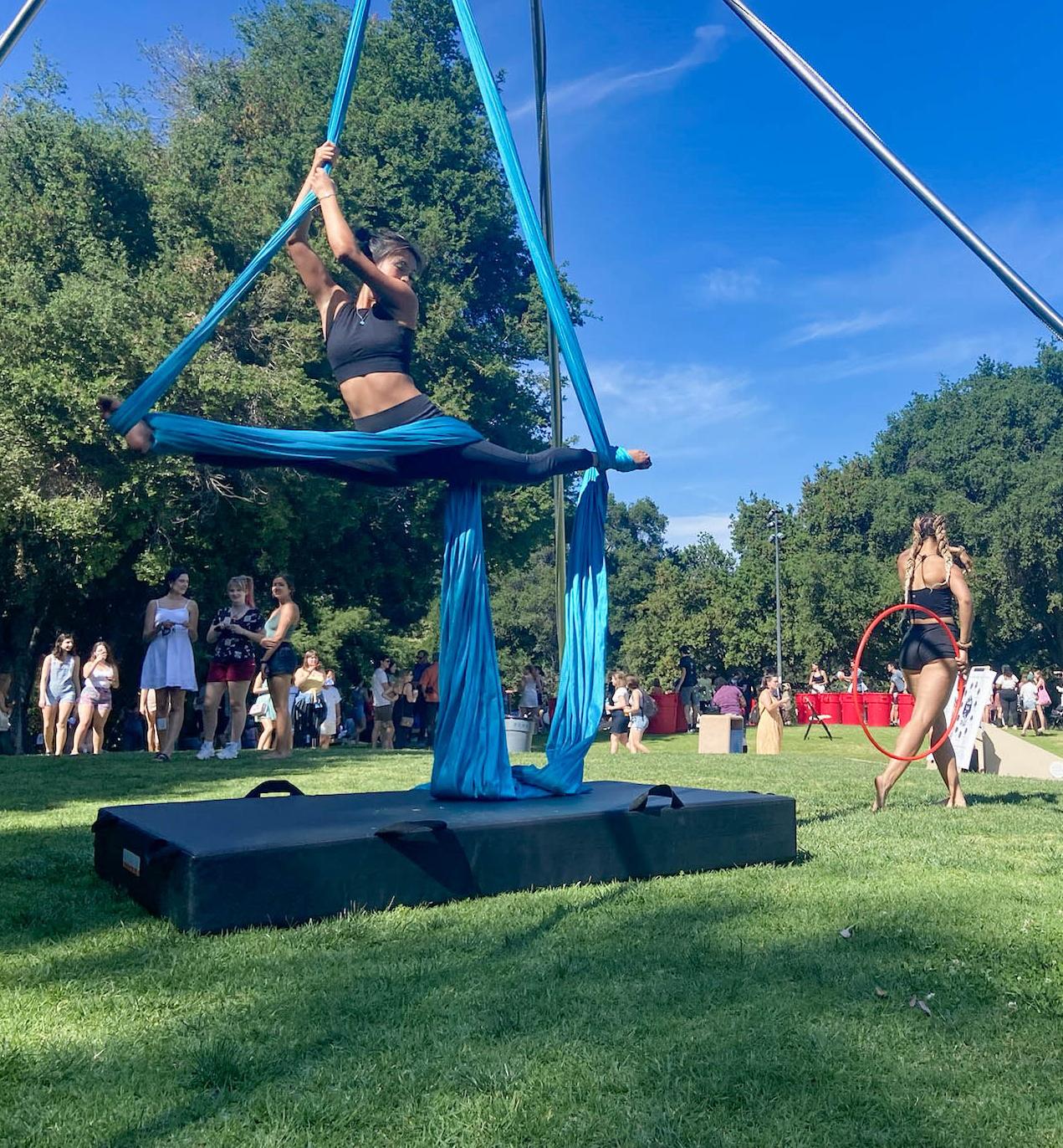

For member Katie Stuart PO ’25, the skill she spends the most time on is her favorite part of Five Cir cus.
“I really enjoy doing the partner acro,” Stuart said. “It’s a lot of fun to come each week and try diferent tricks and see what we can come up with.”
Five Circus president Jacob Li gorria PO ’23 said the best word to describe the club’s vibe is sponta neous.
“Most of the circus is two people never having met before coming into the circus and being interested in what the other person’s doing,” Ligorria said. “It was like, ‘Oh, can
you teach me that?’ And the per son who is teaching is really pas sionate about their art and is eager to teach that to someone else.”
The relaxed practices allow members more liberty in what they do, Ligorria said.
“I would describe circus prac tices as an open gym where we have a skill-sharing session,” Li gorria said.
Clara Meyers PO ’25, the so cial media coordinator for Five Circus, said she benefts from the liberal atmosphere of practices.
“I love that everyone is free to explore each apparatus as they wish, and the structure of each practice is very open-ended afer a group warm-up and seting up the aerials for the day,” Meyers said. “We host workshops, too, and last year we brought in circus instructor Tyler Jacobsen to teach hand balancing and partner acro.”
Meyers said the collaborative community is her favorite part of the club.
“I really enjoy being a part of
Sagehens’ women’s XC looks to run with their best season
YOUNG SEO KIM
Riding on the back of the team’s most successful season last fall, the Pomona-Pitzer women’s cross country team recognizes that the tri umph of the Sagehens this fall will rely on the leadership of its veteran runners.
Afer fnishing 10th at Nation als last year, P-P has looked to run it back with some fresh faces and returning upperclassmen. On Sat urday, the Sagehens hosted the Po mona-Pitzer invite, where the team fnished third overall.
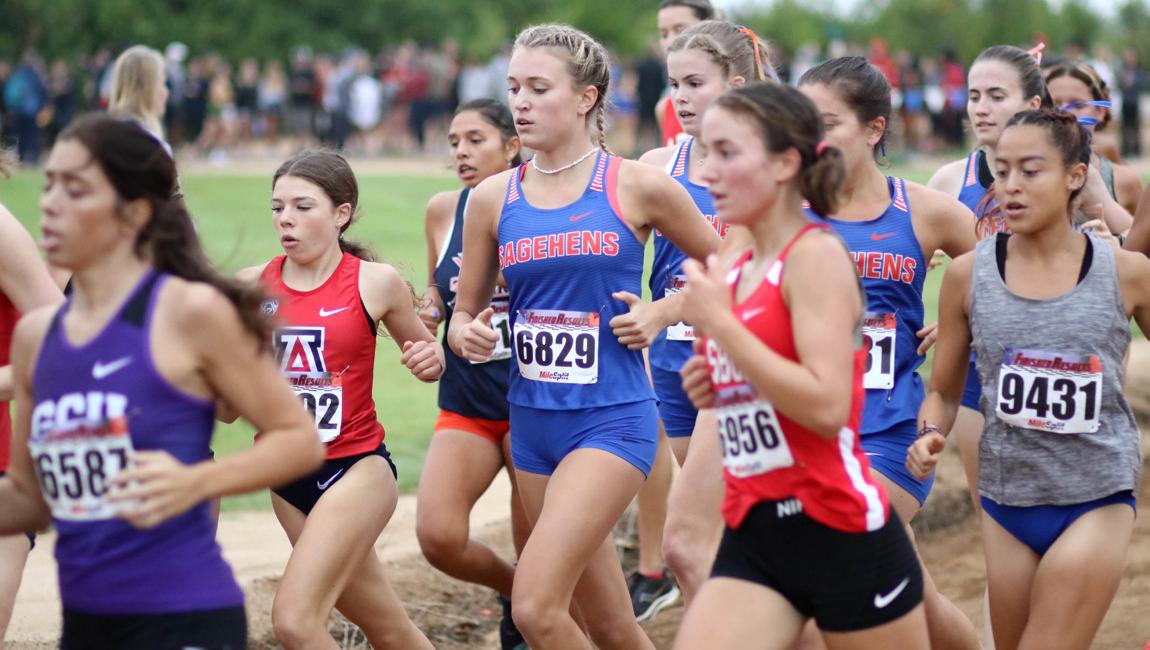
“Our team did a remarkable job training over the summer to prepare for the fall,” Kirk Reynolds, who coaches both P-P women’s track and cross country teams, said. “The fall season is so short that you have to do something in the summer, and all of our team members were pre pared coming into mid-August. It was very rewarding.”
Abigail Louiselle PO ’23 said pre-season is a time to build com munity with teammates.
“I defnitely had a good training block this summer, but I’m iron def cient … which is defnitely not some thing talked enough about in wom en’s running,” Louiselle said. “What got me through, other than medical aid, was defnitely my teammates — the best support system I could ever ask for. They pushed [me] through every workout, encouraged me and told me that it was going to get bet ter, and today it did.”
Louiselle believes the success of this support system is based around the team’s positive energy and abili ty to have fun.
“We just try to laugh as much as possible and make fun of the things we do because if we take it too seri ously, you are just going to be get ting into your own head and hurting yourself,” Louiselle said. “The vibe on the team is certainly welcoming and creative and quirky and all the best stuf about running.”
The culture of the team is rooted in the mentorship of its frst-years by veteran players.
“First-years are adapting well
and learning how to be on a college team, but also how to fgure out how to be in college,” Reynolds said. “So many things changed: dorms, dining halls, coaching staf and friends that surround you … We purposely talk about having the veterans on the team mentor the newcom ers because they remember their own experience and want to help the frst-years.”
While Louiselle is helping new runners begin their college experience, she has her eyes set on the season’s end following her taste of success last year at Na tionals.
“We are looking forward to having a really good race at Na tionals,” she said. “We fnished 10th last year — which is our highest ever in program histo ry — so we’ve been using that momentum to work really hard this summer building up, mak ing sure that we stay healthy and focus on the goals long-term. I know everyone is working their hardest, and I can see the com mitment at every single practice and single race, so I’m really ex cited about how the rest of the season goes.”
Reynolds shared Louiselle’s desire for improvement.
“Now we’re in October, so the meets become a litle more competitive and our team goals concrete,” Reynolds said. “We’re headed to the Big 3 at the end of the season: the conference [championship], regional cham pionship and then the National Championships. Tenth place last fall was a tremendous team achievement, but I know our team can place higher and be among the super elite of Division III.”
The Sagehens will next com pete at both the Augustina XC Invite and UC Riverside Invite on Saturday. The team is also looking forward to competing in the Oct. 29 SCIAC Champi onship, which could book their ticket to Nationals.
Five Circus because the environ ment is so collaborative and ac cepting of all levels,” Meyers said. “Everyone can exchange knowl edge that they have in one area with those who have knowledge about another apparatus or area.”
Since the number of events of fered in the realm of Circus can be daunting for new members, Mey ers ofered advice for prospective performers.
“In terms of where the best place for a beginner to start is, I’d say literally anywhere on both of our aerial apparatus that we use or the silks in the Lyra,” Meyers said. “There are beginner moves to learn, as well as conditioning exercises that you can do with the apparatus to help build up strength, to atempt harder things — even if it’s your frst day doing any kind of circus.”
Ligorria recommended jug gling for entering the realm of Circus.
“Juggling was really helpful because it really enhanced my
hand-eye coordination and got my mind to be in line with my body and to feel more than just think,” Ligorria said. “As long as you start from the very beginning, you can get good at whatever it is for most things.”
A combination of athletic and artistic qualities, Circus can be categorized as both a sport and art, according to Stuart.
“It defnitely requires a degree of athletic ability and strength, but because it’s a performance-based sport, it also requires a degree of artistry as well,” Stuart said.
Ligorria agreed.
“It can be physically draining, especially if you’re doing aerial work or partner acro,” Ligorria said. “However, I would say it’s an art because it is a manifesta tion of your creativity expressed through your body.”
Meyers added that Circus doesn’t need to be contained by a classifcation.
“Ultimately, I don’t really think circus needs classifcation, and it
can mean diferent things for dif ferent people,” Meyers said. “It can range from a workout to a passion to an art form, like dance, to a hob by.”
Although circus requires a level of athletic ability to perform some skills, Five Circus does not compete the same way as other sports. In stead, it performs for events around the 5Cs, which gives members a place to display their skills. Some events they have performed at in clude the Shakespeare Festival and the International Gala.
Ligorria’s favorite part of Five Circus is everyone pushing them selves to do things they never thought they could do, as achieving success in physically and mentally challenging skills not seen on an ev eryday basis is rewarding.
“I never thought I could do jug gling, and now I help teach juggling and circus,” Ligorria said. “I love geting exposed to diferent things that people are so passionate about because you get excited and want to learn as much as you can.”
Stags defense runs over Panthers 28-3 to remain SCIAC’s best
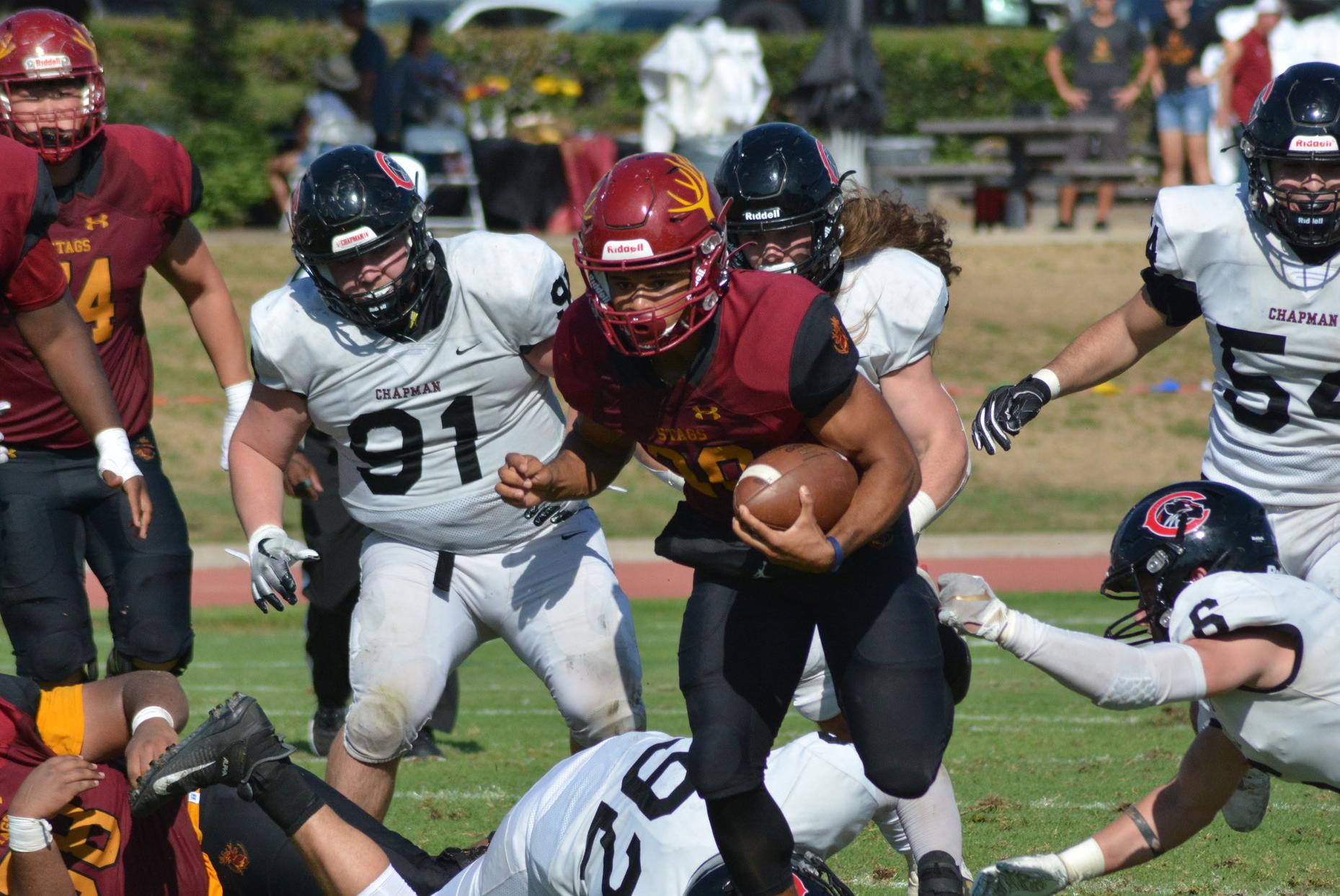 JOHNNY RUSSELL
JOHNNY RUSSELL
When entering the thick of conference play, rarely has an other team been a tougher test for the Stags than the Panthers. In a high-scoring batle last year, Claremont-Mudd-Scripps foot ball barely scraped by Chapman, 42-34. But this season is a difer ent story.
With the sun shining down on Burns Stadium Saturday, CMS defeated Chapman 28-6. The victory extended their win streak to three games and main tained their undefeated record in SCIAC play (2-0).
The Stags defense got all they could handle from Chapman in the initial stages of the game. Holding possession for the en tirety of the frst quarter, the Panthers converted a number of short third downs to move their way downfeld.
However, the CMS defense proved to be up to the task. Af ter a sack by Joey Asta CM ’24 that lef the Panthers with a long fourth down try, Chapman quar terback Jack Alexander threw a pass out of shotgun formation that was intercepted by corner back Kirby Baynes CM ’25. With 70 yards of green grass in front of him, Baynes ran his third inter ception into the end zone for the frst score of the game.
The second Chapman posses sion was just as long, and despite repeated pressure from the CMS defensive line, the Panthers man aged to cut the defcit with a feld goal, making the score 7-3.
A couple 3-and-outs by the CMS ofense in the second quarter allowed Chapman to
continue dominating possession time. Forced to stay on the feld for nearly the entire game to this point, this saw the CMS defense make their frst mistake of the day, allowing a pass deep into their ter ritory be completed for a big gain.
But just as they had previous ly, CMS’ red zone defense would not allow the Panthers to fnd the end zone. Nevertheless, Chap man continued to apply pressure with another feld goal, cuting the Stags’ lead to just one point.
Near the end of the second quarter, the Stag ofense fnally found some momentum. Afer a couple quick throws by Walter Kuhlenkamp CM ’24, the Stags entered Chapman territory for the frst time. On a quick pitch to the outside, running back Brian Lou dermilk CM ’23 made a couple Panthers miss and sprinted into the end zone. The 30-yard touch down extended the CMS lead to eight points heading into halfime.
Coming out of the break, Chapman was ready to play. With the Stags unable to fnd a rhythm, the Panthers drove deep into op posing territory halfway through the third quarter. Still, the Cla remont red zone defense locked Chapman down, with defensive back Michael Colangelo CM ’23 forcing a fumble on the goal line. The Panthers’ second turnover of the day was the spark CMS need ed on both sides of the ball to dominate the Panthers for the rest of the game.
Though not on the feld due to an ACL injury, linebacker Ryan Enney CM ’25 noticed a resur gence in his team’s energy defen sively.
“Everyone on the defense was
making plays,” Enney said. “It was a joy to watch, and it’s all because of Coach Sanders’ game plan. Great job by him to get the team prepared.”
In the fourth quarter, with the Stags pushed back near their own end zone, Justin Edwards CM ’25 showed why he is considered one of the best Division III running backs with a 47-yard run to midfeld. Ed wards would go on to fnish the drive with a 5-yard run for a touch down. This was Edwards’ second touchdown of the game and sixth of the season through just fve games. Edwards had 146 yards rushing on the day against the Panthers, which surpassed his game average of 113.
The third Chapman turnover of the day, a long throw by Alexander intercepted at the goal line, sealed the victory for the Stags. Their ex plosive defense and powerful run ning game with Loudermilk and Edwards overwhelmed the Pan thers as the game progressed. With his defense making plays and the Stags running game unstoppable, Kuhlenkamp was all smiles afer the game.
“It was a great team win,” Kuhlenkamp said. “The defense dominated from the frst whistle to the last, and the ofense controlled the line of scrimmage. I want to give a lot of credit to the big guys up front, we love 99-yard drives on the ground. We coached well, we played for each other and we walked away with another win. Great momentum for the following week.”
On Saturday, the Stags will host Cal Lutheran, which is coming of a loss to Redlands. Kickof is slated for 1 p.m. as the Stags look to im prove their record to 5-1 and remain unbeaten in the SCIAC.
PAGe 10 OctOber 14, 2022Sport S
cOUrteSY: cLArA MeYerS
TESS MCHUGH
Left: two members of the Five circus club perform handstands, creating an arch with their legs.
right: A club member performs on silks while another uses a hoop at the Shakespeare Festival.
A cMS player breaks multiple tackles on the way to a big run. the team looks to extend a winning record into the rest of the season.
cOUrteSY: SteLLA cHeNG
Katie cline PO ’25 leads a group of Sagehens through a pack of run ners at the Pomona-Pitzer Invitational. cOUrteSY: POMONA-PItZer AtHLetIcS


















 CLAIRE DUMONT
CLAIRE DUMONT





 MATSUOKA
MATSUOKA



















 JOHNNY RUSSELL
JOHNNY RUSSELL